- 1Faculty of Medical Sciences, Juntendo University, Chiba, Japan
- 2Department of Biotechnology, Tokyo College of Biotechnology, Tokyo, Japan
- 3Institute of Tropical Medicine, Nagasaki University, Nagasaki, Japan
- 4Yokohama University of Pharmacy, Kanagawa, Japan
- 5Department of Biochemistry and Systems Biomedicine, Graduate School of Medicine, Juntendo University, Tokyo, Japan
Background: As the novel coronavirus disease 2019 (COVID-19) pandemic subsides, the clinical sequelae are becoming more problematic. Interestingly, the statistical data indicate that Africa has experienced the lowest number of cases and deaths, with an unexpected phenomenon where the number of deaths from COVID-19 has not increased significantly. Several studies have investigated the relationship between diet and coronavirus. However, no systematic review/meta-analysis has conclusively linked diet (phytochemicals and vitamin D) and the gut microbiota in the context of COVID-19.
Methods: This study examined the responses to COVID-19 in Japan and Africa, formulating the following hypotheses: (1) a healthy diet is effective against COVID-19, (2) blood vitamin D levels are associated with COVID-19 mortality, and (3) COVID-19 is associated with the gut microbiota. To investigate these hypotheses, a keyword search and meta-analysis were conducted using PubMed, and each hypothesis was tested.
Results: This study found that a healthy diet, particularly rich in phytochemicals such as polyphenols and flavonoids, is effective against COVID-19. An association was detected between blood vitamin D levels and COVID-19 mortality. The gut microbiota was linked to COVID-19 and its amelioration. These findings may have significant implications for not only understanding COVID-19 but also future prevention of pneumonia.
1 Introduction
The COVID-19 pandemic has caused a global crisis, reminiscent of the Spanish flu of 1918, with severe consequences for the global economy. Pneumonia caused by coronaviruses is a zoonosis, and humans have experienced the emergence of three highly pathogenic CoV species over the past two decades: severe acute respiratory syndrome (SARS)-CoV, Middle East respiratory syndrome (MERS)-CoV, and SARS-CoV-2 (1). Its strong infectivity has been verified through transmission from humans to cats, which may have served as intermediate hosts for the virus (2). Regarding the COVID-19 vaccine, some ecological studies have shown regional disparities in immunization coverage in the USA (3). There is concern regarding low vaccination rates despite the greater risk of infection in non-Hispanic Black and Hispanic populations. Data provided by the WHO as of June 17, 2024, showed that the COVID-19 deaths in Africa, the Americas, Europe, the Eastern Mediterranean region, and Asia (Western Pacific and South-East Asia) numbered 175,510 (2%), 3,020,756 (43%), 2,272,390 (32%), 351,975 (5%), and 1,229,712 (17%), respectively (4). Africa had the lowest proportion of cumulative deaths worldwide at 2%, accounting for 9,579,844 cumulative cases and only 1% of the global total.
Contrary to expectations, the number of COVID-19 deaths did not increase significantly in Africa despite the high rates of HIV, malaria, and other infectious diseases and the lack of developed healthcare systems. In contrast, in many developed countries in Europe and the USA, which have large elderly populations, COVID-19 resulted in high mortality rates, especially among the elderly and those with underlying medical conditions. Elderly individuals are more susceptible to pneumonia, with underlying conditions such as diabetes and obesity, which are metabolic conditions included in lifestyle-related diseases, and a weakened immune system due to various diseases. These susceptible populations prioritized vaccination and other preventive measures.
In Africa, an interesting phenomenon was observed: the number of deaths due to COVID-19 did not increase, as expected. However, this anomaly requires further investigation. One possible reason for this is the demographic structure of Africa, which has an overwhelmingly large number of children and a relatively small number of elderly individuals, who showed higher mortality rates from COVID-19. The median age on the African continent is 18.8 years, compared to the world average of 30.7 years and 49.5 years in Japan (5). In children, the innate immune response that eliminates the virus may be more effective than the speed at which the virus mutates (6, 7).
Another explanation is that Japan’s low mortality rate from COVID-19 compared to that in Western countries comes from its status as the country with the longest life expectancy in the world (8). Reports have shown that the nutritional situation in Africa has been adversely affected by the COVID-19 pandemic, particularly among children (9). In addition to economic development, a well-known factor contributing to Japan’s longevity is the healthiness of the Japanese diet. The Japanese diet, similar to the Mediterranean diet (10), has also been considered healthy, particularly around 1975, which is considered healthier than the current Japanese diet (11–13). Compared to the USA and other countries, Japan has lower rates of obesity and lifestyle-related diseases, including metabolic diseases, which are believed to be associated with the longevity of its population. The typical Western diet is high in energy density, leading to underlying and lifestyle-related diseases and impaired immunity due to chronic inflammation, which have been identified as risk factors for COVID-19 (14). This study investigated the effects of polyphenols, a class of phytochemicals abundant in the healthy diets of the Mediterranean region and Japan, on COVID-19.
It is also well-established that vitamin D deficiency is associated with a range of diseases, including those that impair immunity. A systematic review and meta-analysis conducted in Italy, a country severely affected by COVID-19, revealed a clear association between vitamin D deficiency and COVID-19 mortality (15). Blood vitamin D levels are categorized as follows: < 20 ng/mL deficient, 20–30 ng/mL, insufficient; and > 30 ng/mL, sufficient. A report showed the following blood vitamin D (25-OH-D) levels (ng/mL) in European countries: France 24.0, Germany 20.0, Italy 20.0, the UK 19.0, and Spain 17.0 (16). In Japan, only 2% of individuals have sufficient blood vitamin D levels, with an average value of 15.5 ng/mL (17). In Africa, because of the strong direct sunlight, over 40% of people have blood vitamin D levels above 30 ng/mL, with a mean value of 27.1 ng/mL, the highest among the compared regions (18).
Finally, the relationship between the gut microbiota and COVID-19, which is significantly influenced by diet and varies with the disease, was also examined.
Based on the above, this study tested the following hypotheses by examining COVID-19 responses in Japan and Africa: (1) a healthy diet is effective against COVID-19, (2) blood vitamin D levels are associated with COVID-19 mortality, and (3) COVID-19 is associated with the gut microbiota. To test these hypotheses, we conducted a series of literature searches and summarized the findings of a systematic review and meta-analysis.
2 Materials and methods
2.1 Selection criteria, sources, and search strategy
This systematic review follows Cochrane guidelines and reports using Preferred Reporting Items for Systematic Reviews and Meta-Analyses (PRISMA) (19). Compliance with the 2020 Preferred Reporting Items for Systematic Reviews and Meta-Analyses checklist is shown in the Supplementary Table S1. Articles with specific keywords in the title or abstract were selected for this study. The PubMed search engine was used for this systematic review and meta-analysis. The keywords used in this systematic review are: Japan, Africa, polyphenol, flavonoids, vitamin D, and gut microbiota. Polyphenols and flavonoids are major classes of phytochemicals. Four patterns of keyword searches have been shown in the results: Analysis Group A–D.
The protocol was registered in UMIN-CTR under the UMIN study ID: UMIN000054334.1 Ethical approval was not required for this study, as all the data used are publicly available. The examined literature was peer-reviewed and written in English. The search for COVID-19-related articles covered the period from 2019 to the 25th of July 2024.
2.2 Selection procedure and exclusion criteria
Records were initially identified using a PubMed database search. Duplicate records were excluded from the systematic review. Two independent reviewers (KS and RT) assessed the titles, abstracts, and entire articles, including the results of the identified studies, and judged the inclusion and exclusion of any irrelevant reports. Disagreements regarding the inclusion of studies were resolved through discussions and consensus. If disagreements persisted, they were arbitrated by another reviewer. One example of an excluded study is changes in blood 25-OH-D concentration, bone markers, and physical performance due to vitamin D supplementation while COVID (COVID-19) lock down since this study might appear to meet the inclusion criteria, but these were excluded because they were not related to COVID-19 treatment (20). In some analysis groups, articles other than randomized clinical trials (RCTs) were also excluded. A summary of information derived from up-to-date studies on vitamin D was also used as background information.
2.3 Data items and data collection process
Data collection included the following elements: study characteristics (author, year of publication, title, and abstract), participants (selected from relevant RCTs in the context of COVID-19 or long-COVID-19) and keywords in each grouped analysis.
Analysis group A: A two-keyword search was conducted to summarize the COVID-19 responses in Japan and Africa. A keyword search (Japan), (COVID), and (vitamin D, polyphenol, flavonoids, or gut microbiota) yielded 100 results. Only one study was an RCT. Therefore, top 10 search results sorted according to “Best Match” and content related to COVID-19 were showed in the results. Only articles where the full text was available for free were used. Another keyword search, (Africa) and (COVID) and (vitamin D or polyphenol or flavonoids or gut microbiota) yielded 53 results, among which 40 had the full text available for free. Then, top 10 search results sorted by “Best Mach” and title related with COVID-19 were showed in the Tables 1, 2 in the results. Furthermore, two of the four RCTs in the search results as well.
Analysis Group B: For the blood 25-OH-D and COVID-19, search results for (COVID) and (vitamin D) were classified as enough (> 30 ng/mL), insufficient (20 to 30 ng/mL), and deficient (< 20 ng/mL) by the mean concentration of the intervention groups. Of the 1,893 results, 48 were RCTs and were further filtered out based on the availability of free full texts, resulting in 43 articles. From these results, 20 articles containing values of blood 25-OH-D3 with mean ± SD or median were summarized in the table. In addition, a meta-analysis was conducted using the data contained in these articles. Furthermore, a meta-analysis of enough blood 25-OH-D levels (> 30 ng/mL) in the intervention group was conducted.
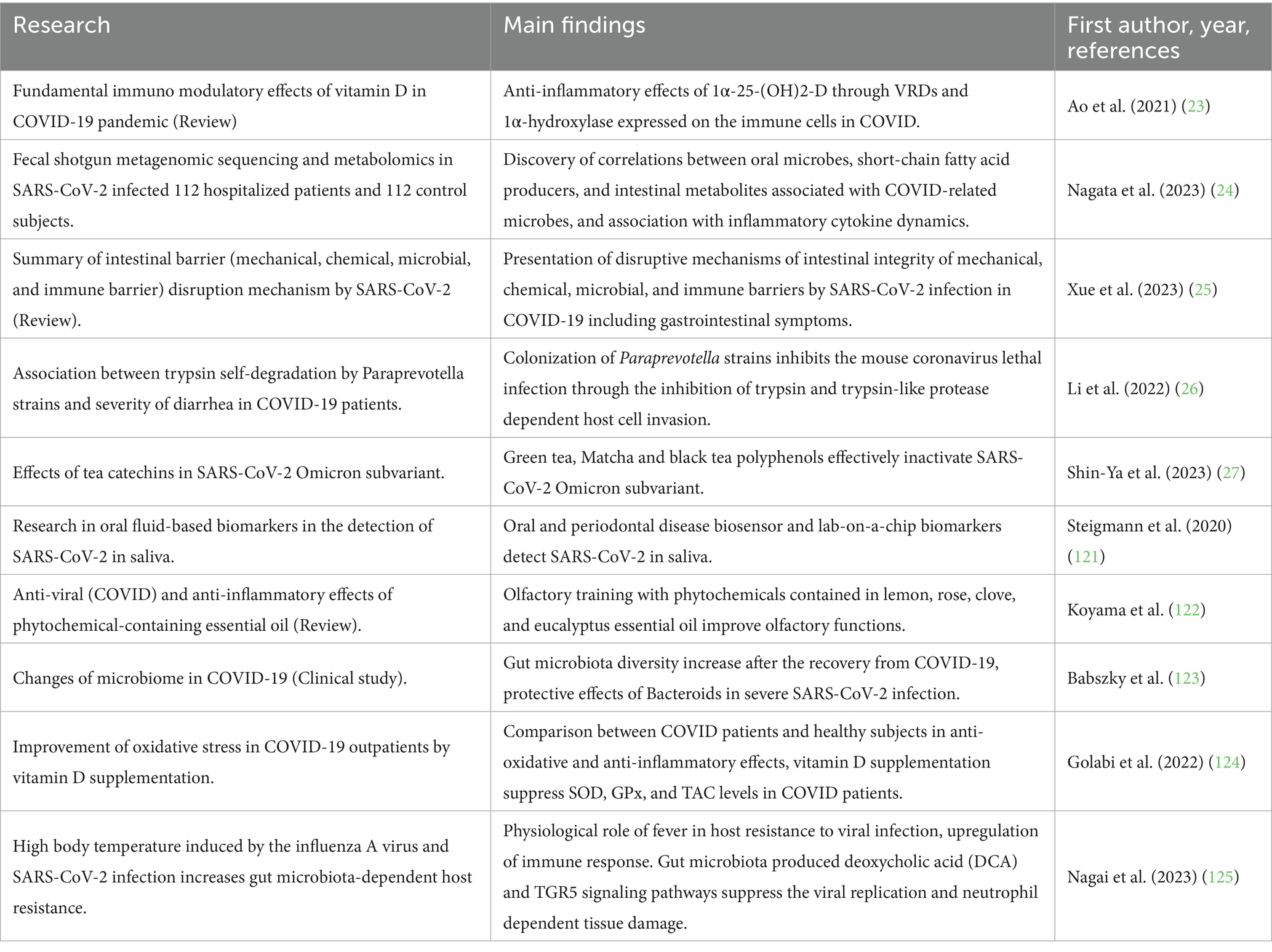
Table 1. Analysis Group A: Top 10 articles sorted by best match in PubMed - Japan, COVID and (polyphenol or flavonoids or vitamin D or gut microbiota) (As of 25th of July).
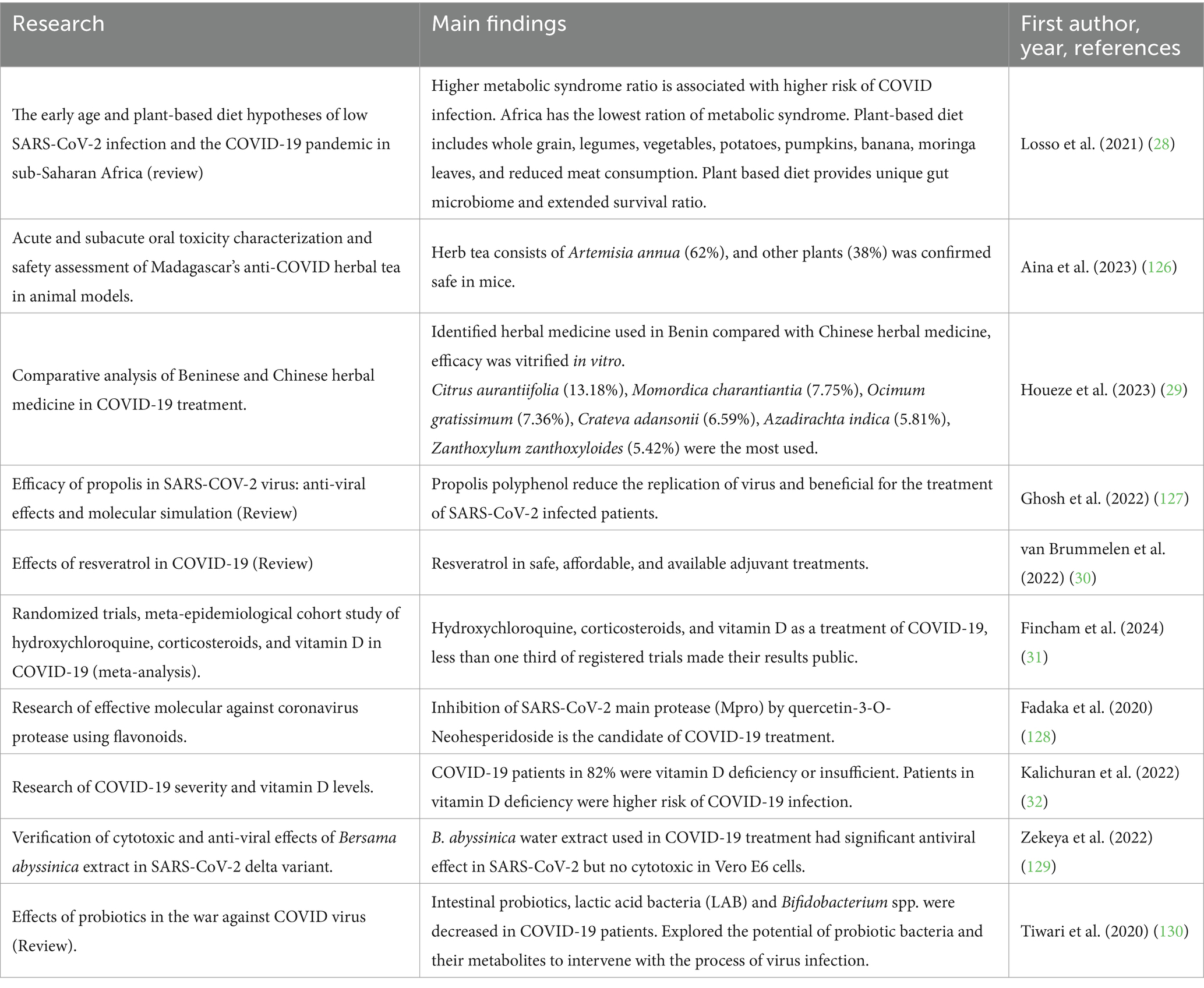
Table 2. Analysis Group A: Top 10 articles sorted by best match in PubMed - Africa, COVID and (polyphenol or flavonoids or vitamin D or gut microbiota) (As of 25th of July).
Analysis group C: Combined keywords (COVID and polyphenol) yielded 410 results, (COVID and flavonoids) yielded 818 results, (COVID and vitamin D) yielded 1,893 results, and (COVID and gut microbiota) yielded 1,012 results. A total of 4,142 studies appeared in the PubMed search. A combined search of (COVID) and (polyphenols, flavonoids, vitamin D, and gut microbiota) showed 3,949 results. Therefore, 193 duplicate results were excluded. As only RCTs were considered, 3,875 articles were excluded, leaving 74 eligible papers. Of these, 33 studies were excluded because they did not meet the exclusion criteria described above. Finally, 41 studies were included in this systematic review. The screening process is described in detail in the PRISMA flowchart (Figure 1). A meta-analysis was performed on the search results for (COVID and vitamin D) in the analysis group C.
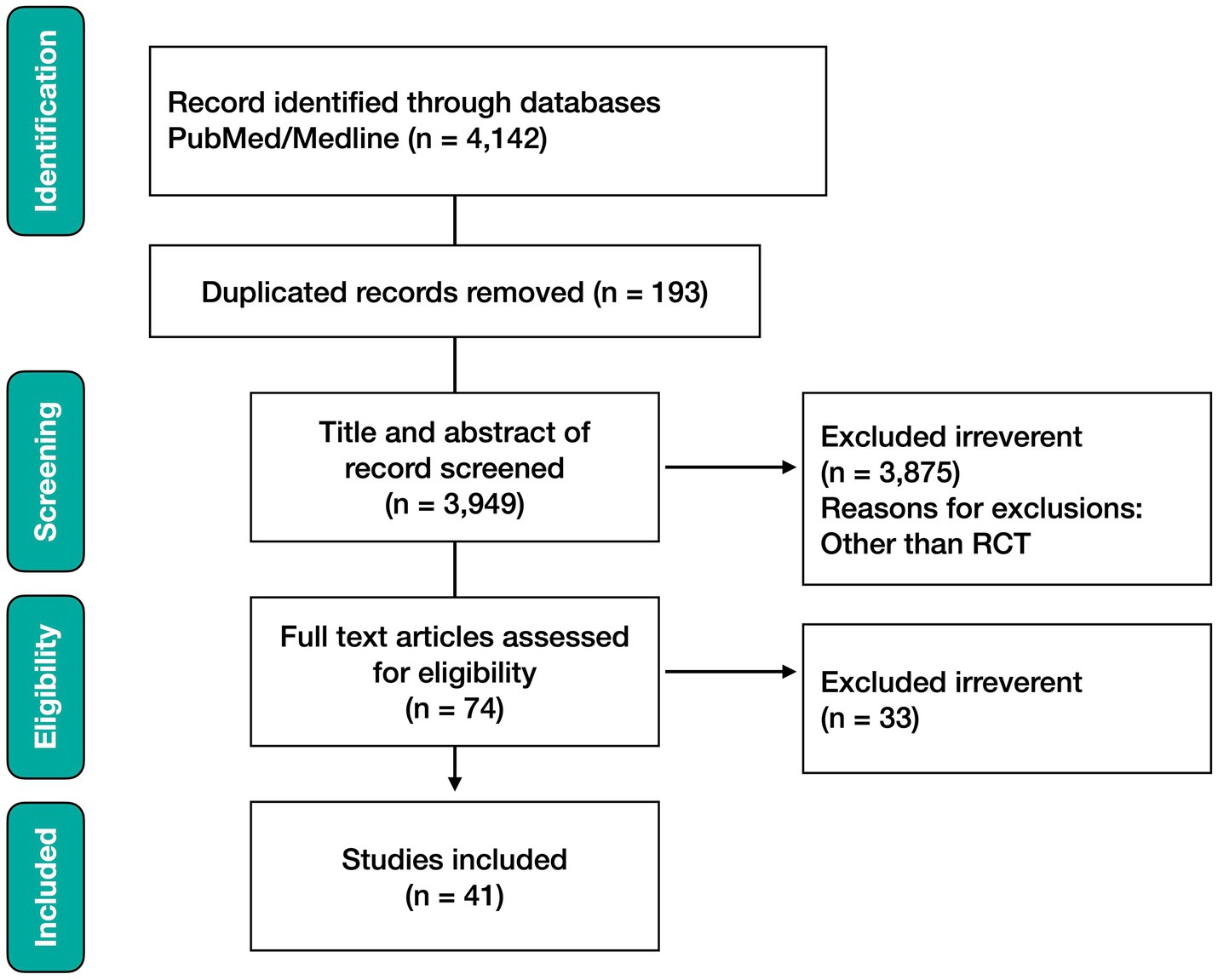
Figure 1. PRISMA flowchart of this systematic review: Analysis Group A. PubMed search with (COVID) and each keyword (polyphenol or flavonoids), (vitamin D), and (gut microbiota) showed 4,142 results. Combined search of (COVID) and (polyphenol or flavonoids or vitamin d or gut microbiota) showed 3,949 results. Duplicated 193 results were excluded. Then, 3,875 results other than randomized clinical trials (RCTs) were excluded and only 74 RCTs were considered further analysis. Of these, 33 studies were excluded based on the exclusion criteria because they did not meet the purpose of the analysis. Finally, 41 manuscripts were exploited in this systematic review (as of 25th of July 2024).
Analysis group D: Existing articles within the 5 years when COVID-19 related articles were available were searched for in PubMed. A combination of keywords (polyphenols or flavonoids) and (gut microbiota) yielded 2,979 results. Within the last 5 years when COVID-19 was prevalent, 2,225 search results were obtained. Of these, 48 were RCTs. When narrowed down to the past year, 573 papers and 9 RCTs were identified, fitting the study’s objectives, resulting in seven papers being included. A PubMed search for (vitamin D) and (gut microbiota) yielded 532 results, with 389 results published in the last 5 years. Among these, 16 were RCTs, and five were fit-for-purpose articles. A PubMed search for (polyphenols, flavonoids) and (vitamin D) yielded 622 results, of which 188 were obtained in the last 5 years. Of these, 11 were RCTs, and six were fit-for-purpose articles.
2.4 Outcome
To verify the three hypotheses: (1) a healthy diet is effective against COVID-19, (2) blood vitamin D levels are associated with COVID-19 mortality, and (3) COVID-19 and gut microbiota are associated, search results from Analysis Groups A, B, C, and D have been summarized into tables in the results section.
2.5 Statistical analysis
A series of meta-analyses of the articles corrected in Analysis Groups B (COVID and vitamin D) and C were conducted (articles in Tables 3–5, 8). Meta-analysis has been performed by EZR [R 4.4.1 binary for macOS 11 (Big Sur)] software downloaded from “The Comprehensive R Archive Network” webpage.2 References including median values were converted to mean ± SD from the first and third tetrad counts. Meta-analysis for means were conducted to analyze the data sets including mean ± SD and total number of samples. The standard mean difference (SMD) with 95% confidence interval (CI) was reported for dichotomous outcomes. A meta-analysis for proportions was conducted to analyze the datasets, including events and the total number of samples. Odds ratios (ORs) with 95% confidence intervals (CI) were reported for dichotomous outcomes. This study performed both fixed-and random-effects modeling. p < 0.01 was considered statistically significant.
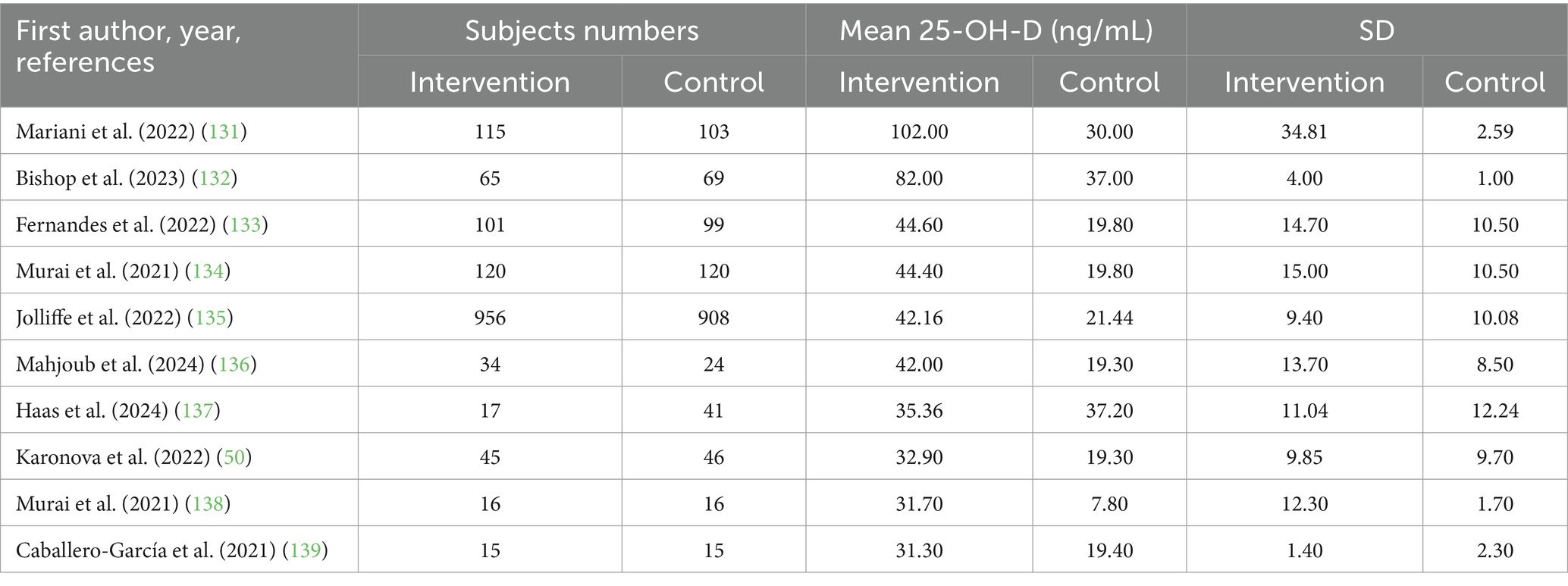
Table 3. Analysis Group B: Association between COVID-19 and blood 25-OH-D3 levels; mean value of the Intervention group showed enough level (> 30 ng/mL) RCT.
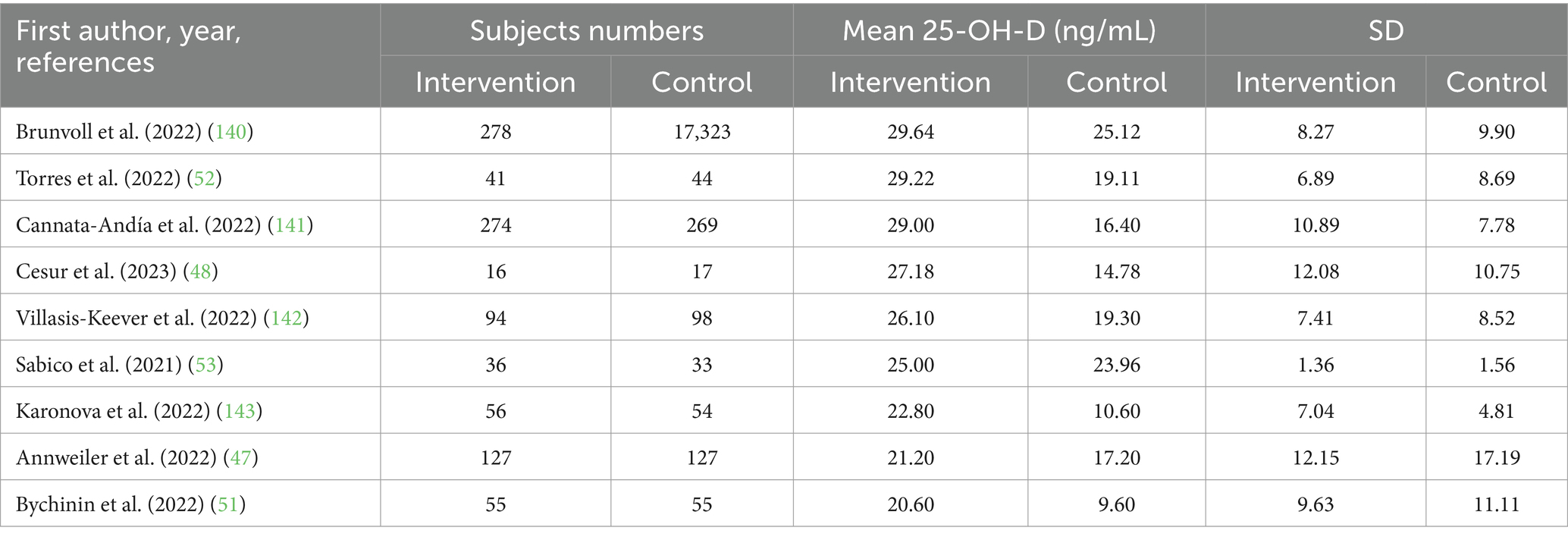
Table 4. Analysis Group B: Association between COVID-19 and blood 25-OH-D3 levels; mean value of the Intervention group was sufficient level (20 to 30 ng/mL) RCT.

Table 5. Analysis Group B: Association between COVID-19 and blood 25-OH-D3 levels; mean value of the Intervention group was insufficient level (< 20 ng/mL) RCT.
3 Results
3.1 Comparison of Japan and Africa’s population
Figure 2 shows the population pyramids of Japan, Africa, and the rest of the world. The largest population group in Japan peaked in the age group of 50–54 (9,510,374 people), followed by the age group of 70–74 (8,218,437 people). These were the second and first baby boomers, respectively (21). The Japanese population is a typical example of an aged society that is common in developed countries, with people older than 65 years comprising a quarter of the population. Surprisingly, the proportion of women older than 100 years was 0.1% in Japan. In contrast, Africa had a typical juvenile population pyramid; as the population became younger, the number of people in Africa increased. However, the world population showed a bell-shaped pyramid. Since COVID-19 vaccination efforts were prioritized for the elderly and people with underlying diseases in Japan, an African population with an enormous number of children was considered one of the reasons for Africa’s low number of COVID-19 deaths.

Figure 2. Population pyramid of Japan, Africa, and the World in 2024. Population pyramid of Japan was a typical shape of an aged society with large numbers of baby boomer seen in developed countries. Population groups peaked around 45–49 and 70–74 years old. Africa had a typical juvenile-formed population pyramid. Population pyramid of the world total was bell-shaped. One reason of Africa’s low death ratio of COVID-19 seemed to come from this very young population distribution.
3.2 Analysis group A: Summary of COVID response in Japan and Africa
3.2.1 Summary of COVID response in Japan
Only one RCT was found after searching for Japanese COVID-19 responses to oral vaccination against Tuberculosis (22). Table 1 summarizes the 10 articles on Japan’s response to COVID-19. These articles were publication types other than RCTs, and were conducted in Japan or by authors belonging to Japanese research institutions. They include a review of the effects of vitamin D against COVID-19 through the vitamin D receptors (VDRs) expressed on the surface of immune cells (23); a metabolomics research related to COVID (24); a review of the mechanism of severe gastrointestinal conditions in COVID-19 (25); association between the enhancement of trypsin self-degradation by Paraprevotella colonization and severity of diarrhea in patients infected with SARS-CoV-2 (26), and effects of green tea catechins on Omicron variants (27).
3.2.2 Summary of COVID response in Africa
Table 2 summarizes the 10 articles associated with COVID-19 responses in Africa. A review article on plant-based diets in sub-Saharan Africa reasoned that a low metabolic syndrome ratio is associated with a low COVID-19 risk in Africa (28). Others include the identification of herbal plants administrated to COVID patients in Benin (29); resveratrol as a safe, affordable, and available adjuvant treatment (30); meta-analysis of corticosteroids, hydroxychloroquine, and vitamin D as treatments for COVID-19 (31); and a report on high COVID-19 risks in patients with vitamin D deficiency (32). Only four RCTs were found in African research; however, one was associated with tuberculosis prevention (33) and the others were about egg consumption to improve diet (34).
3.3 Analysis Group B: Association between COVID-19 and blood 25-OH-D3 levels; deficient, insufficient, and enough amount
Of the 43 RCTs on COVID and vitamin D, 20 articles held mean ± SD or median values were summarized and divided by the serum vitamin D levels of the intervention group into three groups: enough (> 30 ng/mL) amount (Table 3), insufficient (20 to 30 ng/mL) (Table 4), and deficient (< 20 ng/mL) (Table 5). The mean value in the enough amount group varied from 31.3 to 102 (ng/mL), that in the insufficient group varied from 20.8 to 29.64, and the deficiency group had one result with a level of 17.87.
Then, meta-analysis was performed only on studies that met both conditions: blood vitamin D levels of 20 (ng/mL) or higher in the intervention group and 20 or lower in the control group. A meta-analysis performed on articles in Tables 3–5, and the results of adequate heterogeneity (I2 = 72%) are shown in Figure 3A. Another meta-analysis with enough (> 30 ng/mL) blood 25-OH-D levels in the intervention groups are shown in Figure 3B.
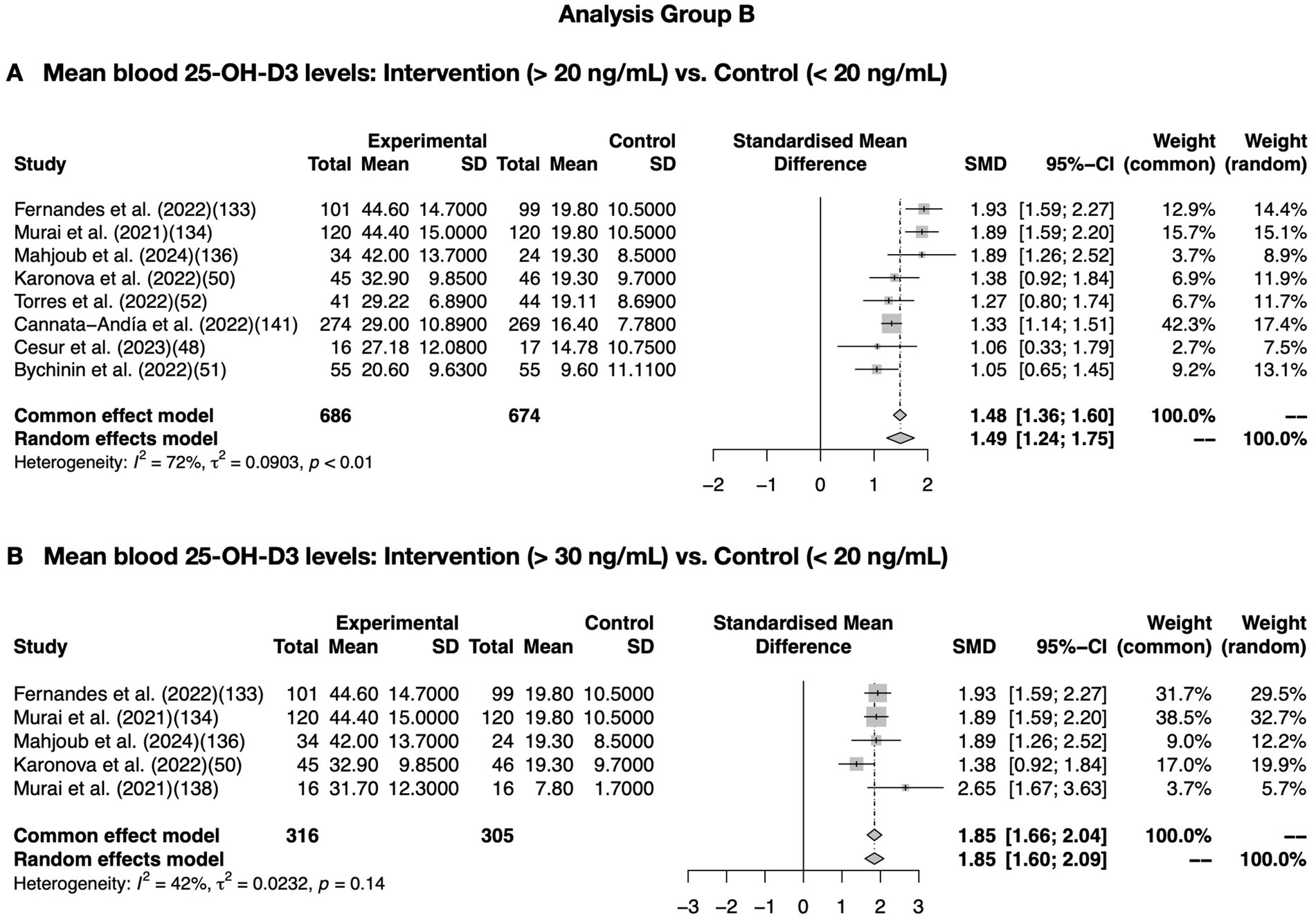
Figure 3. Meta-analysis of association between COVID-19 and vitamin D supplementation in Analysis Group C. meta-analysis conducted using data extracted from articles in Tables 3–5. Meta-analysis was performed only on studies that met both conditions: blood vitamin D levels of 20 (ng/mL) or higher in the intervention group and 20 or lower in the control group. (A) Showed a meta-analysis <I2 = 75% of blood 25-OH-D levels extracted from articles in Tables 3–5. (B) Further shows meta-analysis in combinations of the data of enough (> 30 ng/mL) blood 25-OH-D levels resulted in I2 = 0%. p < 0.01 was considered as a significant difference. p < 0.01 were considered as statistical significance.
3.4 Analysis group C: Nutrients and gut microbiota against COVID-19
3.4.1 Validation of the effectiveness of a healthy diet against COVID-19
This systematic review shows the relevance of polyphenols and flavonoids, two of the most common phytochemicals associated with a healthy diet, in relation to COVID-19. Table 6 summarizes the four RCTs on COVID-19 and polyphenols, and Table 7 summarizes the eight RCTs on COVID-19 and flavonoids. Flavonoids are a typical component of polyphenols. The polyphenol curcumin promotes recovery from COVID-19 by improving blood oxygen saturation (35). Additionally, daily consumption of high-polyphenol olive oil was found to significantly reduce treatment duration (36). Two RCTs involving resveratrol, a polyphenol that was first highlighted for its presence in red wine, were included. The first study demonstrated its effectiveness against respiratory infections, including COVID-19 (37), and the second showed that resveratrol reduced the expression of ACE2, a receptor for COVID-19, in the adipose tissue (38). The flavonoid quercetin was found to reduce the expression of markers associated with COVID-19 severity when combined with anti-viral drugs used to treat COVID-19, such as remdesivir and favipiravir. This included effectively lowering levels of serum alkaline phosphatase (ALP), quantitative C-reactive protein (q-CRT), and lactate dehydrogenase (LDH) (39). Silymarin also reduced alanine aminotransferase levels (40). Several studies in Italy reported that luteolin is effective against olfactory abnormalities, one of the symptoms of COVID (41–45). Additionally, the use of gargles containing the bioflavonoids β-cyclodextrin and Citrox (CDCM) was shown to reduce coronavirus presence (46). Phytochemicals are considered the seventh most abundant nutrient and have been shown to be effective against COVID-19.
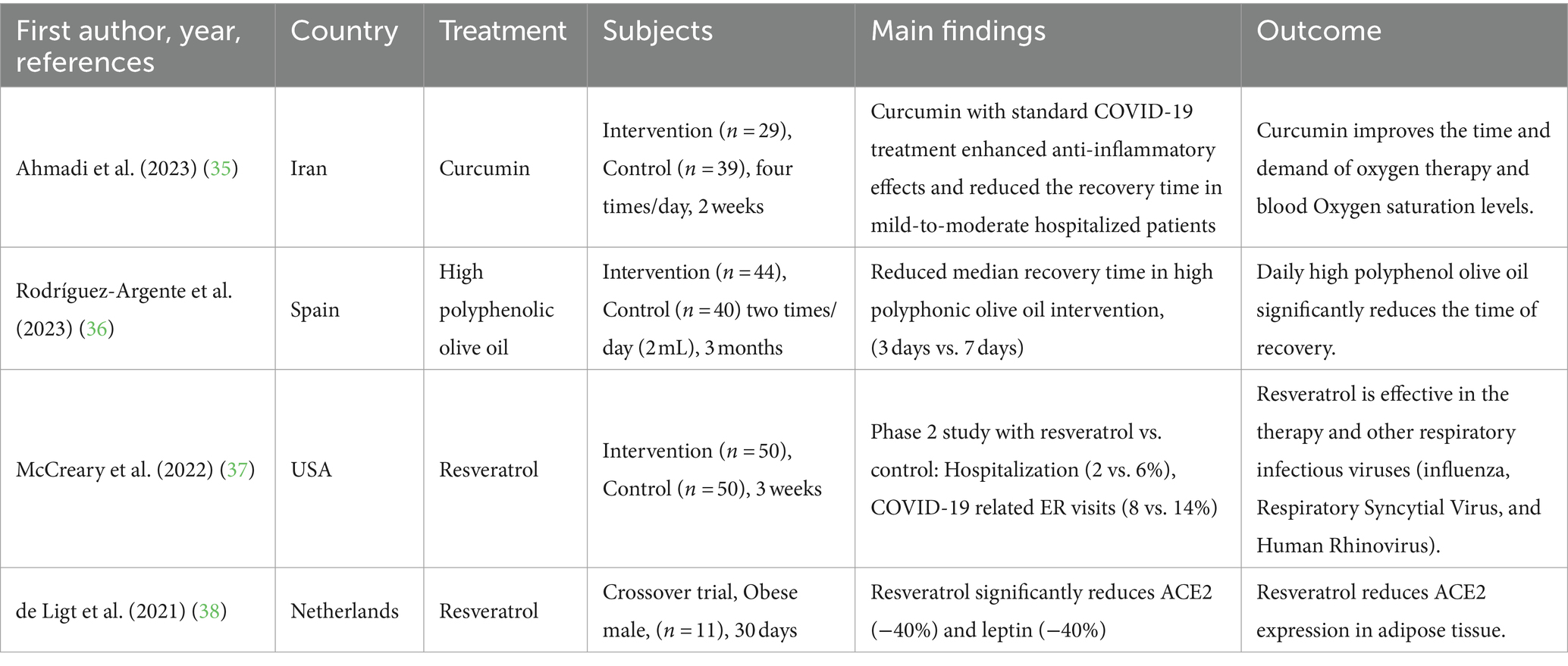
Table 6. Analysis Group C: Effectiveness of a healthy diet against COVID-19 (COVID and polyphenol) RCT.
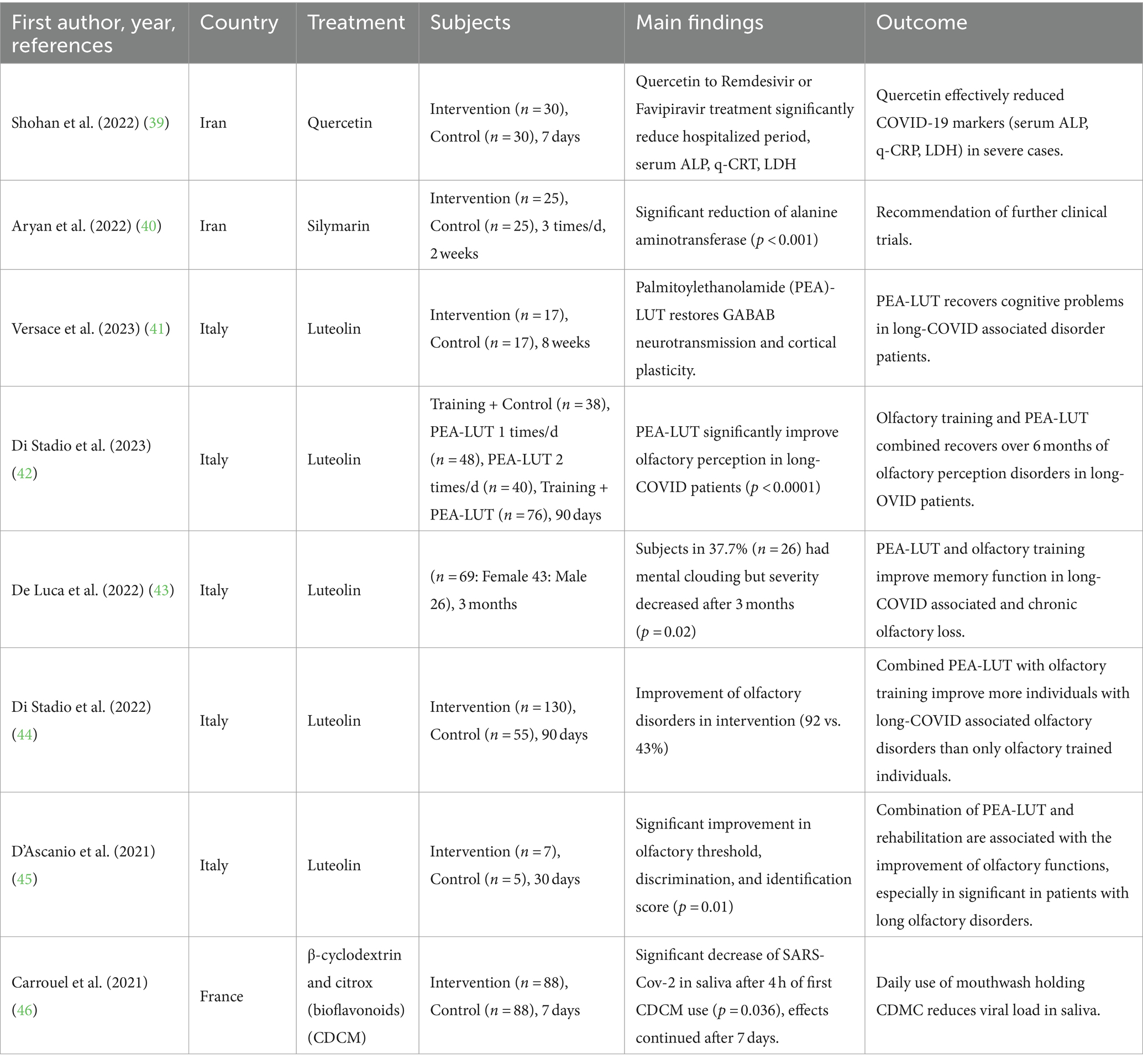
Table 7. Analysis Group C: Effectiveness of a healthy diet against COVID-19 (COVID and flavonoids) RCT.
3.4.2 Validation of the association between blood vitamin D levels and COVID-19 mortality
Table 8 summarizes the relevant RCTs on COVID and vitamin D. Among the 41 studies, 20 were found to be relevant (1 μg = 40 IU). The studies mainly involved the administration of high concentrations of oral vitamin D3, active calcitriol (1α,25-(OH)2-D3), alfacalcidol, and calcidiol (25-OH-D3), which is used to measure vitamin D levels in the blood. The conversion of 25-OH-D3 to calcitriol is facilitated by enzymes in the kidneys or immune cells. High-dose vitamin D3 has been reported to reduce mortality in COVID-19 patients (47) increase vaccine antibody production (48), suppress cytokine storms (49), increase blood 25-OH-D3 levels (50) and lymphocyte counts (51), shorten hospital stays (52), and recovery time (53), reduce healthcare utilization due to COVID-19 (54). There is substantial evidence that vitamin D supplementation is effective during the COVID-19 pandemic and helps improve sequelae such as loss of taste (55).
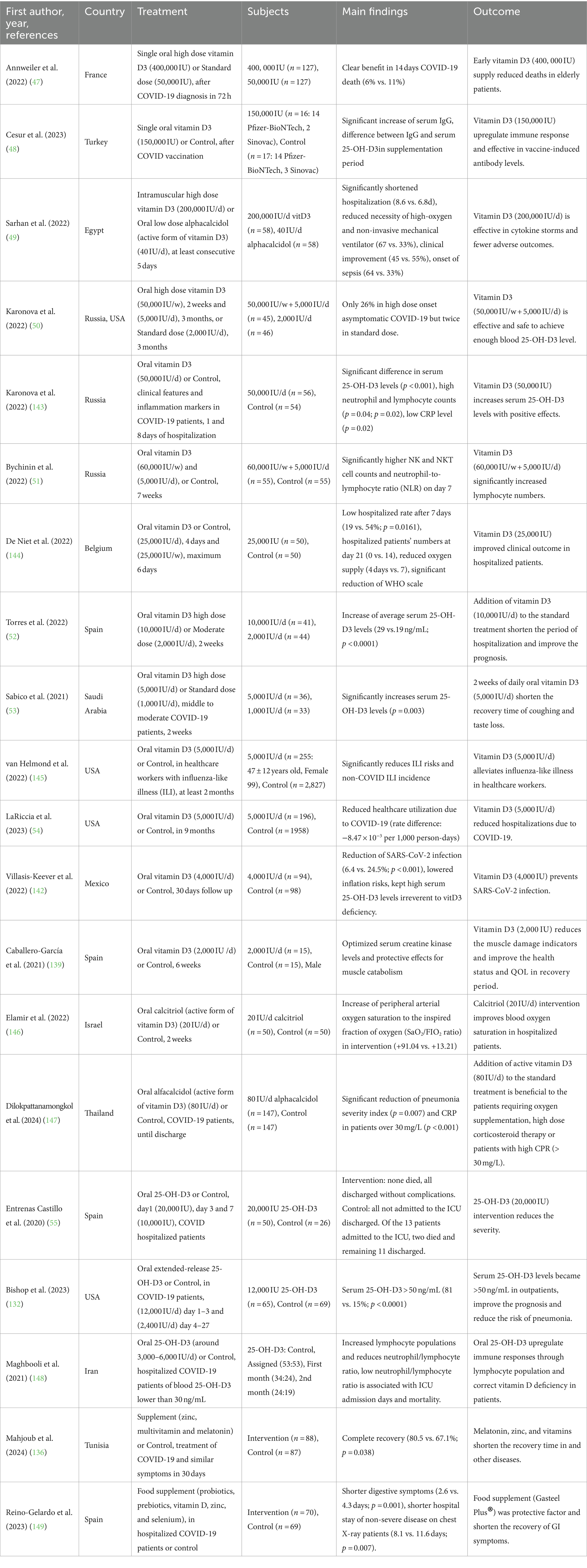
Table 8. Analysis Group C: Association between blood vitamin D levels and COVID-19 mortality (COVID and vitamin D) RCT.
However, it is important to note that long-term intake of higher-than-necessary doses of vitamin D, especially with calcium, should be avoided as it can cause vitamin D toxicity. Therefore, vitamin D should be considered an immune-enhancing nutrient rather than a therapeutic agent.
In addition, a meta-analysis was performed on the 20 articles shown in Table 8, and the quantitative analysis is summarized in Figure 4. Blood 25-OH-D3 levels were found in 12 articles supplemented with vitamin D3 (10 articles) and 25-OH-D3 (two articles). Five articles showing only medians were converted into mean ± SD. The values of the five articles indicating adequate heterogeneity (I2 = 73%) are shown in a forest blot (Figure 4A). Similarly, analysis of two articles showing the length of hospitalization period described in mean ± SD and total number were shown (Figure 4B). Three articles regarding COVID-19 cases (Figure 4C) and two articles regarding COVID-19 deaths (Figure 4D) contained these events; the total numbers are also illustrated. Statistically significant differences (p < 0.01) were observed in blood 25-OH-D3 levels (ng/mL) and number of COVID-19 cases.
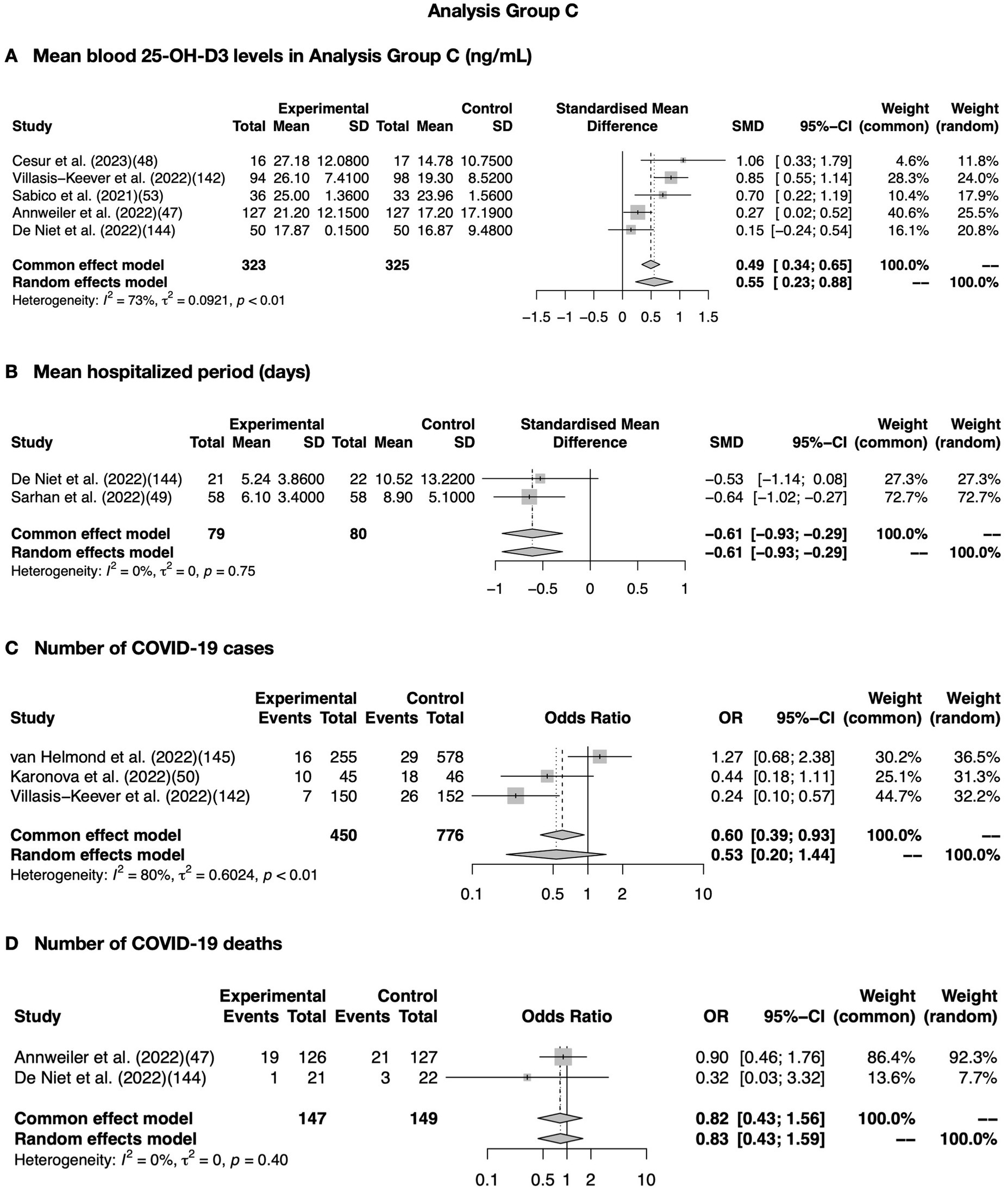
Figure 4. Meta-analysis of association between COVID-19 and vitamin D supplementation in Analysis Group B. Meta-analysis conducted using data extracted from articles in Table 8. (A) Show a meta-analysis of serum 25-OH-D levels combination of <I2 = 75%. (B) Shows a meta-analysis of the difference of mean hospitalized period extracted from articles shown in Table 8. (C) Shows a meta-analysis of COVID cases; data was shown in odds ratio. (D) Shows a meta-analysis of COVID deaths. p < 0.01 was considered as a significant difference.
3.4.3 Verification of the association between COVID-19 and gut microbiota
Table 9 summarizes eight relevant RCTs out of the 12 searched for COVID and gut microbiota. All the retrieved RCTs focused on the effects of prebiotics and probiotics on COVID-19. Two RCTs from China reported a probiotic, SIM01. According to the literature, the symbiotic formulation of SIM01 contains three bacterial strains: Bifidobacterium adolescentis, Bifidobacterium bifidum, and Bifidobacterium longum, and three prebiotic compounds. The first study reported that SIM01 improved intestinal microbiota imbalance (56), and the second reported the alleviation of symptoms in patients with acute post-acute COVID-19 syndrome (PACS) (57). In another report, an aqueous extract of Dendrobium officinale (DoAE) was found to reduce inflammatory gut microbiota (58). Additionally, a Mexican study reported that probiotics containing Lactiplantibacillus plantarum and Pediococcus acidilactici enhance antibody production against COVID-19 by interacting with the host immune system (59). Similarly, a study conducted in the UK found that probiotics, including Lactobacillus acidophilus, Lactobacillus plantarum, Bifidobacterium bifidum, and Bifidobacterium animalis subsp. lactis, reduced the symptoms of viral upper respiratory tract infections (URTI) symptoms by 27% in overweight/obese subjects (60). In Sweden, probiotics containing Limosilactobacillus reuteri have been reported to increase antibody production following vaccination compared to vitamin D alone (61). In a Spanish study, probiotics and prebiotics improved the cardiometabolic profile (62), and in the USA, prebiotic fibers were shown to affect the gut microbiota associated with serum serotonin production and help improve mental health during long COVID (63).
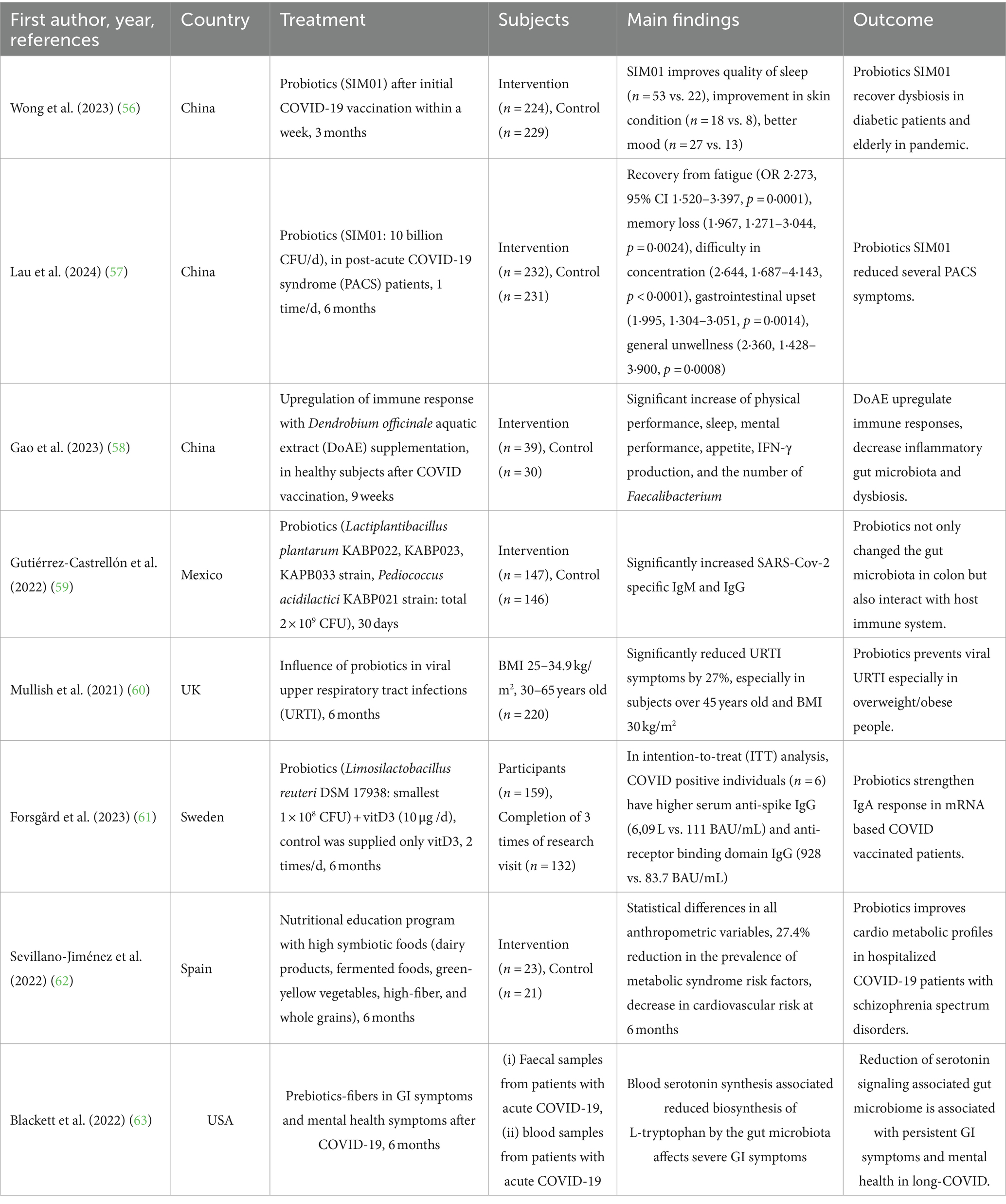
Table 9. Analysis Group C: Association between COVID-19 and gut microbiota (COVID and gut microbiota) RCT.
Thus, the gut microbiota plays a significant role in improving COVID-19 outcomes and sequelae, as evidenced by a systematic review.
3.5 Analysis group D: Association between healthy diet, phytochemicals, vitamin D, and gut microbiota
3.5.1 Association of polyphenols or flavonoids with gut microbiota
The results of the PubMed search for polyphenols, flavonoids, and the gut microbiota are shown in Table 10. As there were 30 RCTs reporting these associations over a 5-year period, the seven main articles from the past year are listed below.
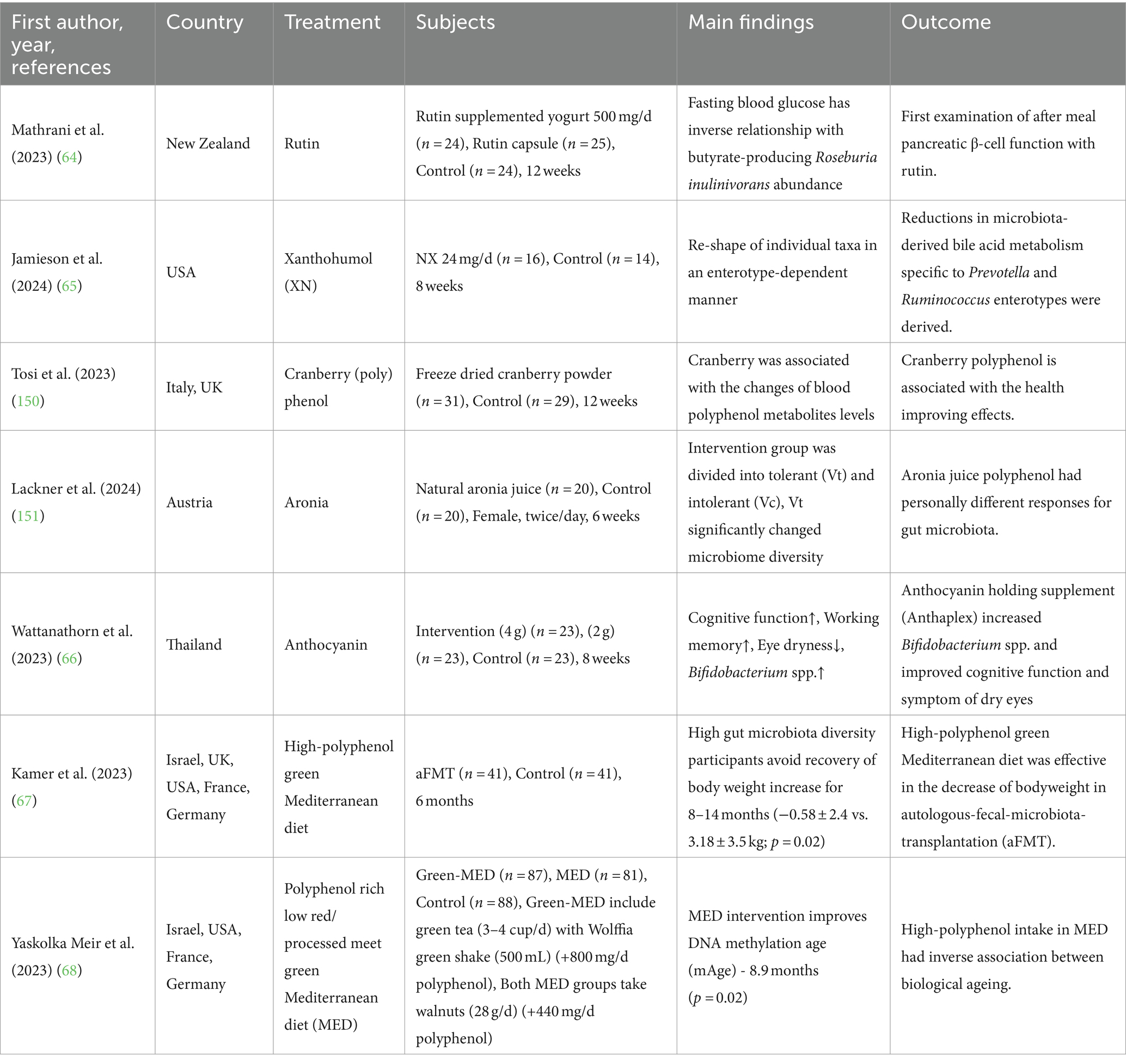
Table 10. Analysis group D: Association of polyphenols or flavonoids with gut microbiota (polyphenol or flavonoids and gut microbiota) RCT last 1 year.
A study from New Zealand indicated a relationship between the intake of rutin-supplemented yogurt and an increase in the number of butyrate-producing bacteria and decrease in fasting blood glucose levels (64). In an American study, xanthohumol found in hops reduced bile acid metabolism via microbiota specific to the gut forms of Prevotella and Ruminococcus (65). Functional foods containing anthocyanins increased Bifidobacterium and improved cognitive function and eye dryness (66). Additionally, autologous fecal transplantation was effective in weight loss among consumers of a high-polyphenol Green Mediterranean Diet (67). An interesting finding was the inverse association between the Green Mediterranean diet and biological aging in the group with increased polyphenol intake (68).
These results highlight the significant impact of polyphenols and flavonoids on the gut microbiota composition and related health outcomes. Modulation of the gut microbiota by these compounds may offer protective benefits and improve overall health, particularly in the context of dietary interventions aimed at enhancing gut health and preventing disease.
3.5.2 Association between vitamin D and gut microbiota
The results of the PubMed search for vitamin D and the gut microbiota are shown in Table 11. Several recent RCTs conducted over the past 5 years have demonstrated that vitamin D supplementation significantly affects changes in the gut microbiota. One year of supplementation with vitamin D (2,000 IU/day) in patients with colorectal cancer (CRC) resulted in a significant increase in Leuconostoc pseudomesenteroides, Ruminococcus YE78, Faecalibacterium prausnitzii, and Bacteroides clarus (69). Additionally, 16 weeks of vitamin D3 supplementation in vitamin D-deficient, overweight/obese individuals led to an increase in Lachnospira spp., a decrease in Blautia spp., and an increase in Coprococcus spp., while decreasing Ruminococcus spp. in groups with high serum vitamin D levels (70). Intramuscular vitamin D3 (200,000 IU) increased Bifidobacteriaceae and Christensenellaceae and decreased Proteobacteria after 8 weeks (71). Other findings suggest that increased vitamin D levels during pregnancy protect against the growth of sulfate-reducing bacteria such as Desulfovibrio, which are associated with chronic intestinal inflammatory disorders (72). Studies on vitamin supplementation, including that of vitamin D, have also shown increased microbial alpha diversity and short-chain fatty acids (73).
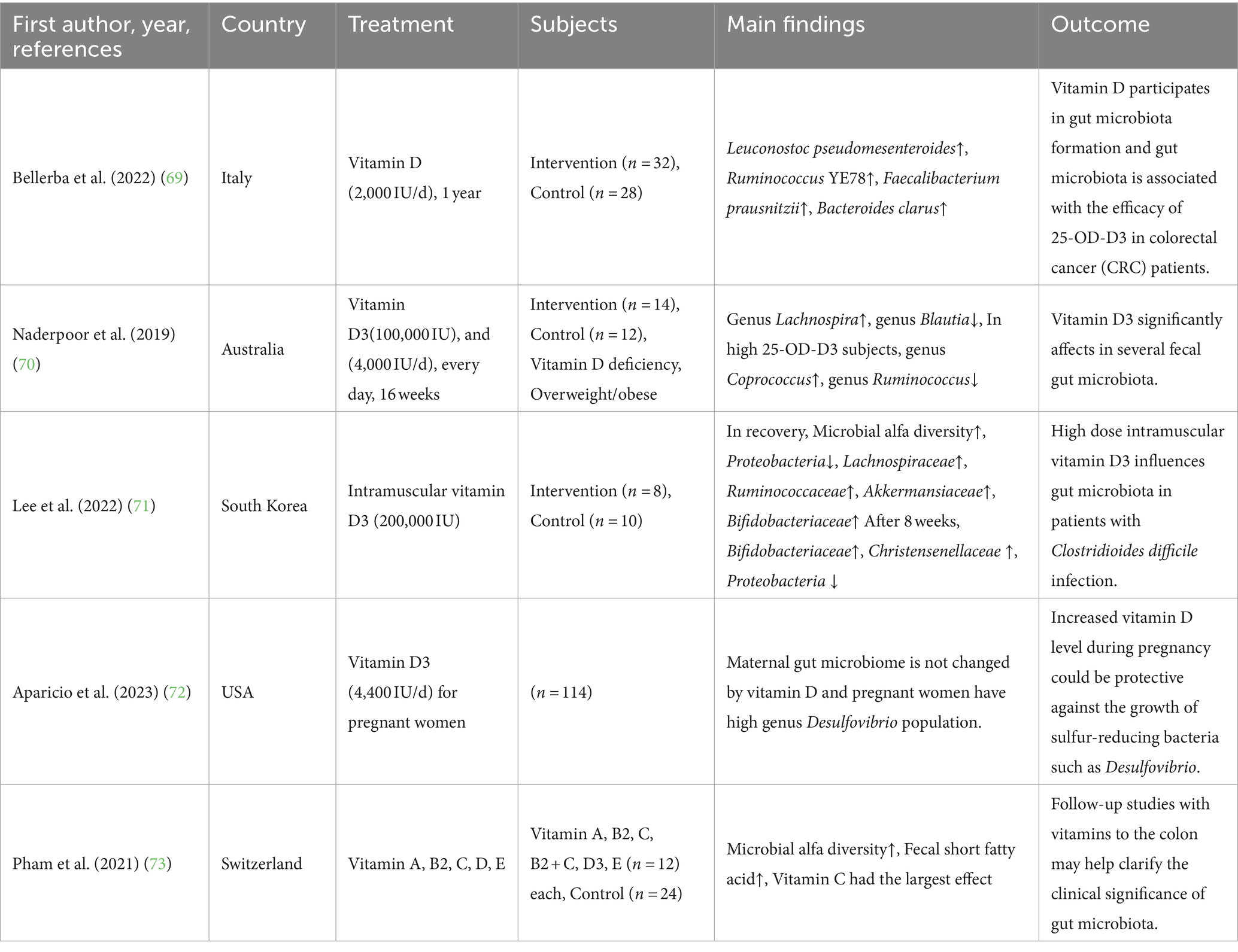
Table 11. Analysis group D: Association between vitamin D and gut microbiota (vitamin D and gut microbiota) RCT last 5 years.
These findings highlight the significant role of vitamin D in modulating the gut microbiota, which may have implications for overall health and management of diseases related to gut health. The beneficial effects of vitamin D on the gut microbiota composition suggest its potential therapeutic application, particularly in conditions involving gut dysbiosis and inflammatory disorders.
3.5.3 Relevance of phytochemicals and vitamin D
The association between vitamin D, an essential nutrient, and polyphenols and flavonoids, the main components of the phytochemical group, shown in Table 12 after a PubMed search. Several studies have highlighted synergistic effects of these nutrients.

Table 12. Analysis group D: Relevance of phytochemicals and vitamin D (polyphenol or flavonoids and vitamin D) RCT last 5 years.
First, curcumin supplementation led to significant improvements in blood vitamin D levels and liver function enzyme levels in women with premenstrual syndrome (PMS) and dysmenorrhea (74). Second, the osteoprotective effect of resveratrol was greater in the participants who were supplemented with vitamin D and calcium (75). Additionally, supplementation of the Mediterranean diet with apple and bergamot juices in an Italian study reduced the risk of chronic noncommunicable diseases (CNCD) and increased VDR gene expression (76). Silymarin combined with vitamin D improves nonalcoholic fatty liver disease (NAFLD) (77). Furthermore, a combination of alpha-lipoic acid, acetyl-L-carnitine, resveratrol, and vitamin D3 supplementation with rehabilitation was effective for sciatica (78). Perilla frutescens dried seed extract, containing quercetin and vitamin D3, has also been shown to be effective against pediatric allergic rhinitis (79).
As described above, a link was observed between dietary factors, phytochemicals, vitamin D, and the gut microbiota, as well as between phytochemicals and vitamin D. These findings indicated that a healthy dietary pattern is an important long-term protective factor against pneumonia, including COVID-19.
4 Discussion
This systematic review first examined whether a healthy diet was effective against COVID-19. Japan has the longest longevity in the world, and in recent years, there has been growing awareness of the need to reduce medical costs and prevent aging, particularly by detecting and curing non-disease conditions (ME-BYO) (80). Consequently, considerable research has been conducted on healthy longevity and diet (81). Unlike the typical high-fat, high-sugar Western diet, the Japanese diet, which is similar to the Mediterranean diet, is well-known worldwide as a healthy diet, making those who consume it less prone to metabolic-related diseases and obesity (82).
In developed countries, high infection and mortality rates owing to COVID-19 have been observed, particularly among the elderly and those with underlying diseases, who constitute a large proportion of the population. Consequently, these groups are prioritized for vaccination (83). A healthy Japanese diet may be associated with lower rates of COVID-19 due to the lower prevalence of underlying lifestyle-related diseases in the population.
Africa, on the other hand, is a region with a poor food situation, including hunger and water shortages, and the economic impact of COVID lockdowns and other problems was a major concern (84). However, contrary to our expectations, the reported number of deaths due to COVID-19 did not increase significantly. One reason is that since Africa’s situation cannot be compared with that of other regions owing to underdeveloped health systems, the COVID response in Africa has been underreported. In addition, regional differences exist between the urban and non-urban areas in Africa. However, the proportion of younger people is the highest in the world, and the proportion of patients with metabolic syndrome, lifestyle-related diseases, and diseases caused by overeating is lower than in developed and emerging countries (85). This is associated with the fact that COVID-19 mortality rates were low in Africa.
Vegetables and fruits have received attention in recent years because of their high phytochemical content (86). They are referred to as the seventh nutrient, following the three macronutrients—carbohydrates, proteins, and fats—the fourth and fifth nutrients—vitamins and minerals, and the sixth nutrient–dietary fiber. Phytochemicals have gained particular attention owing to their anti-inflammatory effects and well-known antioxidant properties. Numerous studies have investigated the antibacterial, anti-viral, and anti-cancer properties of these compounds. Grape phytochemicals such as resveratrol are among the most widely studied and used compounds (87). Many other plant-derived ingredients are extensively utilized not only in foods, but also in Kampo (traditional Japanese) and other herbal medications, from aspirin to the antimalarial drug artemisinin.
Next, we examined whether blood vitamin D levels were associated with COVID-19 mortality. Recently, there have been an increasing number of reports on the immune-boosting properties of vitamin D (88). Vitamin D was named after Elmer McCollum in 1922 as the fourth vitamin, with Vindaus et al. contributing to early research. It is well-known for its role as a bone hormone and its involvement in calcium absorption in the intestinal tract. Vitamin D deficiency is well known to be associated with rickets in children (89) and osteoporosis and osteomalacia in the elderly (90).
Vitamin D toxicity can lead to hypercalcemia and calcium accumulation in blood vessels caused by excessive vitamin D intake combined with calcium intake. This effect could be reversed by preventing excessive vitamin D intake. There are two types of vitamin D: plant-derived vitamin D2, produced in mushrooms, and animal-derived vitamin D3. Vitamin D3 is produced in the body from cholesterol precursors in the skin, but the activated form, 1α,25-(OH)2-D3, has a short half-life of a few hours and is not excessive in its natural state.
It is also well known that African Americans living in temperate regions are often deficient in vitamin D3, as its production in skin cells is inhibited by high melanin levels (91). For similar reasons, vitamin D supplementation is recommended, particularly in the UK and Scandinavian countries because of the high prevalence of vitamin D deficiency at higher latitudes (92). As mentioned previously, vitamin D deficiency is much less common in mainland Africa than in other countries. A study comparing East Africa and Finland found that East Africans had a higher vitamin D intake (93), with differences in diet and sunlight exposure across regions being associated (94).
It has also been suggested that in Africa, unlike in developed countries where the population is concentrated in urban areas, there are far more opportunities for exposure to direct sunlight owing to differences in living conditions. Therefore, sufficient vitamin D is synthesized despite the high melanin pigmentation in the skin (95). This phenomenon is attributed to the fact that people living at higher latitudes lose the need for pigments that protect their bodies from direct sunlight.
In recent years, it has been noted that vitamin D deficiency is associated with compromised immunity, since vitamin D receptors (VDRs) expressed in many cells, including immune cells (96). Active vitamin D, bound to the nuclear VDR, binds to the vitamin D response elements of genes and regulates their expression of various genes. This action is particularly prominent in proinflammatory cytokine genes such as TNF-α and IL-1β, thereby providing vitamin D with anti-inflammatory properties and making it deeply involved in immune regulation (97).
There were remarkable numbers of meta-analysis in PubMed search (65 results) associated with the keywords COVID-19 and vitamin D (98). Therefore, a meta-analysis was conducted from the references in Tables 3–5, 8, and the statistical analysis of blood 25-OH-D3 levels, hospitalization period, COVID-19 cases, and deaths in relationship to COVID-19 and vitamin D. Statistically significant differences (p < 0.01) in blood 25-OH-D3 levels and number of COVID-19 cases were observed in this study, similar to other meta-analyses. However, it is likely that vitamin D works as supplementary regimen for daily upregulation of immune responses to avoid infections rather than the treatment of severe COVID-19.
Contrary to prior predictions, there was no significant increase in the number of deaths from COVID-19 in Africa despite the high prevalence of other infectious diseases such as AIDS and malaria (99). Although vitamin D deficiency is common in Africa, it is less prevalent than that in other regions of the world. Therefore, it is highly likely that higher average blood vitamin D levels in Africa are associated with improved survival rates. In contrast, mortality from COVID-19 was associated with blood vitamin D levels, similar to trends observed in other regions.
Finally, we examined whether COVID-19 is associated with the gut microbiota. In recent years, gut microbiota have been found to be associated with various diseases (100). The gut microbiota of the Japanese people can be categorized into five types. The gut microbiota phenotype of healthy Japanese individuals is referred to as the rural type and is characterized by high levels of Prevotella, which is associated with a reduced risk of various diseases (101). A study of African children found that, compared to their European counterparts, children in rural African villages had an enrichment of Bacteroides and a reduction of Firmicutes, resulting in a more diverse and healthier gut microbiota (102). This was attributed to the primitive, fiber-rich diet of Africans with healthy low Firmicutes/Bacteroides (F/B) ratio and linked to the low COVID-19 infection rates and deaths in Africa, presenting a remarkably interesting finding.
Patients with COVID-19 show reduced diversity of microbiota in the lungs, including a reduction in Bacteroides (103). Focusing on the gut microbiota, it was found that short-chain fatty acid-producing bacteria, mainly from the class Clostridia decreased, whereas opportunistic pathogens increased, resulting in leaky gut syndrome (104). Short-chain fatty acids, such as acetic acid, propionic acid, and butyric acid, are crucial for the activation of regulatory T cells (Tregs) and upregulate immunity. Furthermore, an increase in opportunistic pathogens, including mycoplasmas, has been observed in the respiratory tracts of COVID-19 patients (105). Opportunistic pathogens are normally present in the body but become pathogenic when the immune system is weakened. Thus, a link between COVID-19 and the gut microbiota has been suggested.
In addition, vitamin D helps maintain healthy gut microbiota (106). The composition of the gut microbiota varies greatly depending on the diet and can be broadly classified into obese and lean types. Obese individuals contain more Firmicutes, whereas lean individuals often have more Bacteroides (107). A typical Western diet, which is high in fat, sugar, and red meat, increases the number of obese Firmicutes. In contrast, a high-fiber diet rich in vegetables and fruits, such as the Japanese diet, the Mediterranean diet, the Five-a-Day diet in the USA, and vegetarian and vegan diets, increases Bacteroidetes (108). The Mediterranean diet, a representative healthy diet, is characterized by low intake of sweets and red meat, daily consumption of whole grains with a low glycemic index (GI), extra virgin olive oil, and approximately one glass of red wine per day. Additionally, daily physical activity is recommended as part of the Mediterranean diet pyramid.
The Japanese diet is also characterized by a high intake of foods that maintain a healthy gut microbiota, including low fat intake, high fish protein, and fermented foods (109). On the other hand, it is interesting to note that African villages have a primitive diet very high in dietary fiber, which maintains the diversity of the intestinal microbiota and a low Firmicutes/Bacteroidetes (F/B) ratio, which is considered healthy (110).
Figure 5 summarizes the mechanisms underlying the improvement in COVID-19 responses by phytochemicals (polyphenols and flavonoids), vitamin D, and gut microbiota. Phytochemical effects against COVID-19 via various mechanisms. First, phytochemicals not only prevent the production of proinflammatory cytokine TNF-α production but also prevent cytokine storms caused by COVID-19. The suppression of chronic inflammation prevents obesity and metabolic syndrome-related diseases, which are responsible for the onset of underlying diseases. The anti-viral effects of phytochemicals are well known. Furthermore, phytochemicals function as prebiotics and maintain a healthy gut microbiota.
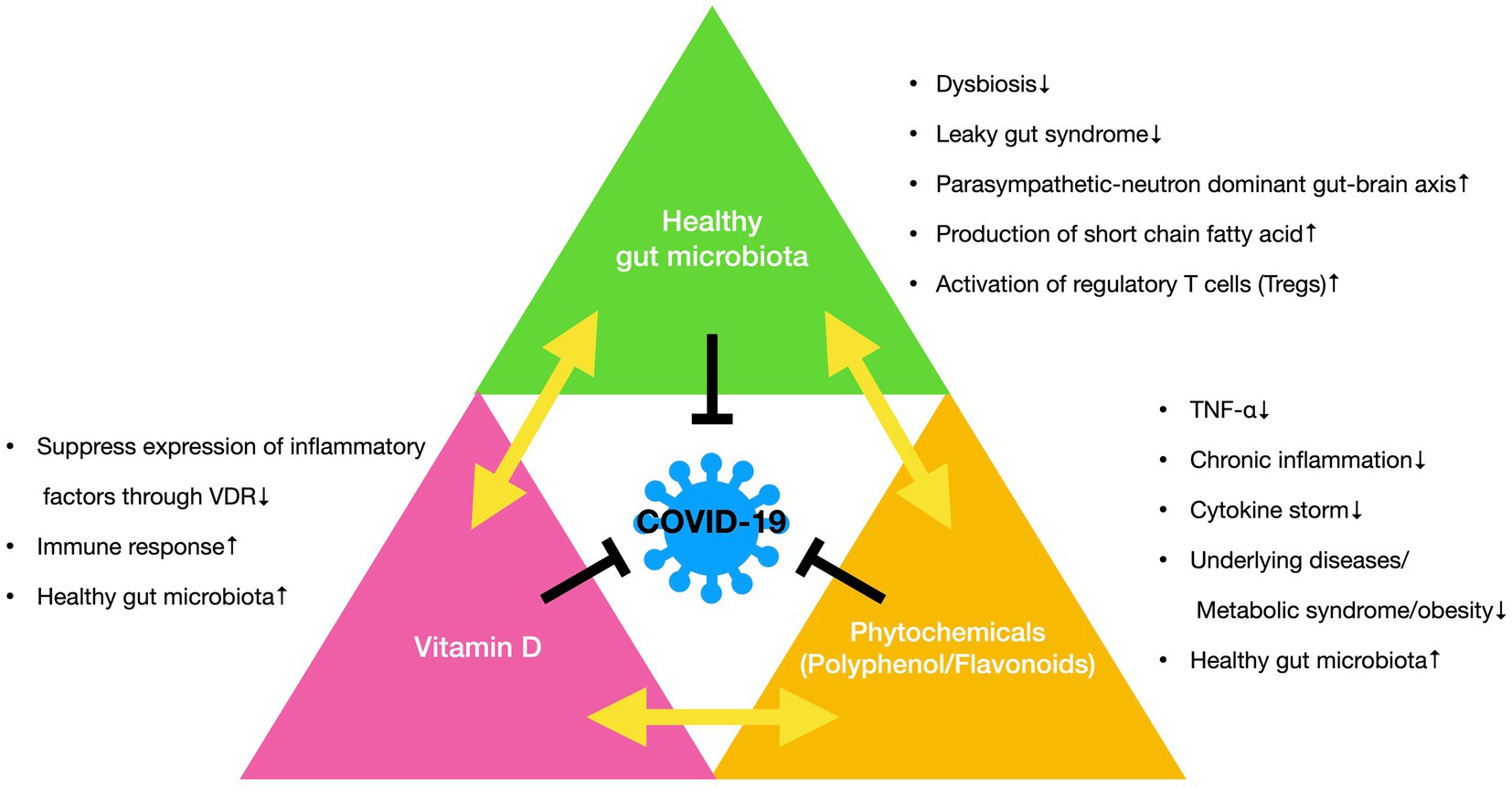
Figure 5. The mechanisms behind the improvement of COVID-19 responses by phytochemicals (polyphenol and flavonoids), vitamin D and gut microbiota. Phytochemicals prevent the production of proinflammatory cytokine TNF-α production; reduce chronic inflammation; prevent cytokine storms; and underlying diseases, metabolic syndrome, and obesity. Vitamin D suppresses the expression of inflammatory factors through vitamin D receptors (VDRs); upregulates immune responses; and maintains of healthy gut microbiota. Healthy gut microbiota is nurtured by both phytochemicals and vitamin D. Maintenance of healthy gut microbiota prevents dysbiosis; leaky gut syndrome; parasympathetic-neuron dominant gut-brain axis; production of short fatty acids; and upregulation of regulatory T cells (Tregs). These are associated with the prevention of the onset of COVID-19.
Recent findings on vitamin D have demonstrated its effects on the upregulation of the immune system. Since most immune cells express vitamin D receptors (VDRs), vitamin D suppresses the transcription pathways of inflammation-associated genes and cytokine storms observed in COVID-19. Vitamin D deficiency has been observed in many deadly diseases, and their supplementation boosts immune responses. Furthermore, vitamin D intake is associated with the maintenance of healthy gut microbiota.
Maintenance of a healthy gut microbiota is associated with systemic health conditions. The onset of COVID-19 is associated with dysbiosis. This induces leaky gut syndrome, which enables the penetration of bacteria and their toxins into the bloodstream and circulation around the body, thereby inducing inflammation. Malfunction of the intestine is one of the chief symptoms of COVID-19 that worsens the condition of patients. Furthermore, the gut microbiota is associated with the maintenance of the gut-brain axis and induces a parasympathetic-neuron-dominant state related to stress reduction. In addition, short fatty acids produced by the gut microbiota activate regulatory T cells (Tregs) and prevent the manifestation of symptoms even after infection with SARS-CoV-2.
Acute pneumonia due to COVID-19 resembles sepsis caused by various infections and viruses (111). In COVID-19, SARS-CoV-2 infection causes inflammation, primarily in the lower respiratory tract, and disseminated intravascular coagulation (DIC) occurs when a cytokine storm spreads throughout the body, leading to severe symptoms and death. The mechanism is an inflammatory response, such as septic shock, triggered by infections and not just viruses. Long-term COVID-19 continues to pose a problem (112). This condition is caused by an inflammatory response that affects various parts of the body, including nerve cells, resulting in an increase in the number of aging cells. The challenge in treating long COVID, as to sepsis, is the removal of senescent cells. The antimicrobial peptide LL-37 (113), which activates innate immunity, and K-FGF (114, 115), a functional food containing phytochemicals produced from Japanese grapes (fermented grape food from Koshu), are effective in this regard.
A limitation of this study is that the medical systems in developed countries such as Japan and Africa are very different, making it difficult to determine how well recorded figures capture the actual situation. Japan has also experienced a collapse in medical systems owing to COVID-19, such as a shortage of ambulances in Tokyo; however, the medical system has been well developed. By contrast, in Africa, the population with access to hospitals is much more limited. Some reports have indicated the possibility of underestimating the impact of COVID in Africa (116). The most conceivable reason derived from the serosurveillance data is significant underdetection and underreporting (117). However, it is possible that these phenomena are applicable only to limited areas, including conflict zones (118). Second, Japan has a long life expectancy and a declining population, while in Africa, the population continues to grow and there are many children, creating completely different population pyramids. Furthermore, ACE2, the receptor for SARS-CoV-2 infection, is less expressed in young people (119), and Africans have many genetic polymorphisms, the frequency of which differs from that of people in other regions (120).
Regardless of these differences, it is necessary to consider the possibility that directly applying findings obtained from one region to another may be difficult. Moreover, with predicted future developments, healthy features such as high blood vitamin D levels and diverse gut microbiota in Africa may be lost.
Notably, in this study, COVID-19 deaths in Africa were unexpectedly low, accounting for only 2% of the global deaths. This low mortality rate is attributed not only to the high proportion of children in the population, but also to the relatively low number of people with underlying metabolic and obesity-related diseases, which are mainly caused by overeating. Additionally, high average blood vitamin D levels and, more notably, a low Firmicutes/Bacteroidetes (F/B) ratio and a highly diverse gut microbiota are contributing factors. These factors may explain the lower incidence of COVID-19 and less severe disease outcomes in Africa than in developed and emerging countries. These results are indeed very interesting.
The authors have already shown that a healthy diet containing nutrients such as phytochemicals and vitamin D is associated with a healthy gut microbiota. In this context, the present study, based on an article review, shows that phytochemicals and vitamin D are involved in the improvement of COVID-19 and its sequelae by maintaining a healthy gut microbiota. Further epidemiological studies are required to confirm these findings and explore the potential of dietary interventions to mitigate the impact of COVID-19 and improve overall public health.
5 Conclusion
A comparison of the Japanese and African COVID-19 responses confirmed the importance of a healthy diet. Vitamin D is related to vitamins, and its deficiency threatens the health of the body. However, it is now recognized as an immune-related hormone. Phytochemicals have also become attractive as the seventh most important nutritional source for a healthy diet in recent years. Maintaining adequate blood vitamin D levels and taking phytochemicals are associated with maintaining a healthy and diverse gut microbiota and upregulation of immune responses, which are correlated with a low mortality rate from COVID-19. This study suggests that healthy dietary patterns and nutrients are important long-term protective factors against lung diseases, including COVID-19, and may also help prevent other diseases such as sepsis caused by infections. Promoting a diet rich in phytochemicals and ensuring sufficient vitamin D intake could serve as effective strategies to enhance public health and mitigate the global impact of infectious diseases.
Data availability statement
The datasets presented in this study can be found in online repositories. The names of the repository/repositories and accession number(s) can be found at: https://center6.umin.ac.jp/cgi-open-bin/ctr_e/ctr_view.cgi?recptno=R000062073.
Ethics statement
Ethical approval was not required for the studies involving humans because all data used are publicly available. The studies were conducted in accordance with the local legislation and institutional requirements. Written informed consent for participation was not required from the participants or the participants' legal guardians/next of kin in accordance with the national legislation and institutional requirements because all data used are publicly available.
Author contributions
KS: Writing – original draft, Writing – review & editing. RT: Writing – original draft, Writing – review & editing. KW: Writing – original draft, Writing – review & editing. IN: Writing – original draft, Writing – review & editing.
Funding
The author(s) declare that financial support was received for the research, authorship, and/or publication of this article. This work was supported by the JSPS KAKENHI (grant nos.: 20K07486 and 23K06549).
Acknowledgments
We thank Satoshi Nunomura for suggesting the investigation of intestinal microflora as a parameter, Sonoko Habu for giving us the opportunity to write this paper, and Yoshio Kumazawa for his guidance during the health course.
Conflict of interest
The authors declare that the research was conducted in the absence of any commercial or financial relationships that could be construed as a potential conflict of interest.
The author(s) declared that they were an editorial board member of Frontiers, at the time of submission. This had no impact on the peer review process and the final decision.
Publisher’s note
All claims expressed in this article are solely those of the authors and do not necessarily represent those of their affiliated organizations, or those of the publisher, the editors and the reviewers. Any product that may be evaluated in this article, or claim that may be made by its manufacturer, is not guaranteed or endorsed by the publisher.
Supplementary material
The Supplementary material for this article can be found online at: https://www.frontiersin.org/articles/10.3389/fnut.2024.1465324/full#supplementary-material
Footnotes
References
1. Sayama, Y, Okamoto, M, Saito, M, Tamaki, R, Saito-Obata, M, Quicho, RFN, et al. Lack of zoonotic coronavirus species detected among children hospitalized with pneumonia in the Philippines. Clin Infect Dis. (2023) 77:1612–3. doi: 10.1093/cid/ciad430
2. Halfmann, PJ, Hatta, M, Chiba, S, Maemura, T, Fan, S, Takeda, M, et al. Transmission of SARS-CoV-2 in domestic cats. N Engl J Med. (2020) 383:592–4. doi: 10.1056/NEJMc2013400
3. Lacy, A, Khan, MM, Deb, NN, Das, P, Igoe, M, Lenhart, S, et al. Geographic disparities and predictors of COVID-19 vaccination in Missouri: a retrospective ecological study. Front Public Health. (2024) 12:1329382. doi: 10.3389/fpubh.2024.1329382
4. COVID-19 Epidemiological Update . (2024) Available at: https://www.who.int/publications/m/item/covid-19-epidemiological-update-edition-168 (Accessed June 1, 2024).
5. WORLDOMETER . Population. (2024) Available at: https://www.worldometers.info/population/ (Accessed July 23, 2024).
6. Nogrady, B . How kids' immune systems can evade COVID. Nature. (2020) 588:382. doi: 10.1038/d41586-020-03496-7
7. Weisberg, SP, Connors, TJ, Zhu, Y, Baldwin, MR, Lin, WH, Wontakal, S, et al. Distinct antibody responses to SARS-CoV-2 in children and adults across the COVID-19 clinical spectrum. Nat Immunol. (2021) 22:25–31. doi: 10.1038/s41590-020-00826-9
8. Watanabe, M . The COVID-19 pandemic in Japan. Surg Today. (2020) 50:787–93. doi: 10.1007/s00595-020-02033-3
9. Aborode, AT, Ogunsola, SO, and Adeyemo, AO. A crisis within a crisis: COVID-19 and hunger in African children. Am J Trop Med Hyg. (2021) 104:30–1. doi: 10.4269/ajtmh.20-1213
10. Greene, MW, Roberts, AP, and Frugé, AD. Negative association between Mediterranean diet adherence and COVID-19 cases and related deaths in Spain and 23 OECD countries: an ecological study. Front Nutr. (2021) 8:591964. doi: 10.3389/fnut.2021.591964
11. Kushida, M, Sugawara, S, Asano, M, Yamamoto, K, Fukuda, S, and Tsuduki, T. Effects of the 1975 Japanese diet on the gut microbiota in younger adults. J Nutr Biochem. (2019) 64:121–7. doi: 10.1016/j.jnutbio.2018.10.011
12. Sugawara, S, Kushida, M, Iwagaki, Y, Asano, M, Yamamoto, K, Tomata, Y, et al. The 1975 type Japanese diet improves lipid metabolic parameters in younger adults: a randomized controlled trial. J Oleo Sci. (2018) 67:599–607. doi: 10.5650/jos.ess17259
13. Asano, M, Kushida, M, Yamamoto, K, Tomata, Y, Tsuji, I, and Tsuduki, T. Abdominal fat in individuals with overweight reduced by consumption of a 1975 Japanese diet: a randomized controlled trial. Obesity. (2019) 27:899–907. doi: 10.1002/oby.22448
14. Tadayon, NB, Rayner, DG, Shokraee, K, Shokraie, K, Panahi, P, Rastgou, P, et al. Obesity as an independent risk factor for COVID-19 severity and mortality. Cochrane Database Syst Rev. (2023) 5:CD015201. doi: 10.1002/14651858.CD015201
15. D'Ecclesiis, O, Gavioli, C, Martinoli, C, Raimondi, S, Chiocca, S, Miccolo, C, et al. Vitamin D and SARS-CoV2 infection, severity and mortality: a systematic review and meta-analysis. PLoS One. (2022) 17:e0268396. doi: 10.1371/journal.pone.0268396
16. Ilie, PC, Stefanescu, S, and Smith, L. The role of vitamin D in the prevention of coronavirus disease 2019 infection and mortality. Aging Clin Exp Res. (2020) 32:1195–8. doi: 10.1007/s40520-020-01570-8
17. Miyamoto, H, Kawakami, D, Hanafusa, N, Nakanishi, T, Miyasaka, M, Furutani, Y, et al. Determination of a serum 25-Hydroxyvitamin D reference ranges in Japanese adults using fully automated liquid chromatography-tandem mass spectrometry. J Nutr. (2023) 153:1253–64. doi: 10.1016/j.tjnut.2023.01.036
18. Mogire, RM, Mutua, A, Kimita, W, Kamau, A, Bejon, P, Pettifor, JM, et al. Prevalence of vitamin D deficiency in Africa: a systematic review and meta-analysis. Lancet Glob Health. (2020) 8:e134–42. doi: 10.1016/S2214-109X(19)30457-7
19. Page, MJ, McKenzie, JE, Bossuyt, PM, Boutron, I, Hoffmann, TC, Mulrow, CD, et al. The PRISMA 2020 statement: an updated guideline for reporting systematic reviews. BMJ. (2021) 372:n71. doi: 10.1136/bmj.n71
20. Jastrzębska, J, Skalska, M, Radzimiński, Ł, López-Sánchez, GF, Weiss, K, Hill, L, et al. Changes of 25(OH)D concentration, bone resorption markers and physical performance as an effect of Sun exposure, supplementation of vitamin D and lockdown among young soccer players during a one-year training season. Nutrients. (2022) 14:521. doi: 10.3390/nu14030521
21. Populationpyramid.net . Available at: (2024). https://www.populationpyramid.net/japan/2024/ (Accessed July 29, 2024).
22. Yuki, Y, Nojima, M, Hosono, O, Tanaka, H, Kimura, Y, Satoh, T, et al. Oral MucoRice-CTB vaccine for safety and microbiota-dependent immunogenicity in humans: a phase 1 randomised trial. Lancet Microbe. (2021) 2:e429–40. doi: 10.1016/S2666-5247(20)30196-8
23. Ao, T, Kikuta, J, and Ishii, M. The effects of vitamin D on immune system and inflammatory diseases. Biomol Ther. (2021) 11:1624. doi: 10.3390/biom11111624
24. Nagata, N, Takeuchi, T, Masuoka, H, Aoki, R, Ishikane, M, Iwamoto, N, et al. Human gut microbiota and its metabolites impact immune responses in COVID-19 and its complications. Gastroenterology. (2023) 164:272–88. doi: 10.1053/j.gastro.2022.09.024
25. Xue, W, Honda, M, and Hibi, T. Mechanisms of gastrointestinal barrier dysfunction in COVID-19 patients. World J Gastroenterol. (2023) 29:2283–93. doi: 10.3748/wjg.v29.i15.2283
26. Li, Y, Watanabe, E, Kawashima, Y, Plichta, DR, Wang, Z, Ujike, M, et al. Identification of trypsin-degrading commensals in the large intestine. Nature. (2022) 609:582–9. doi: 10.1038/s41586-022-05181-3
27. Shin-Ya, M, Nakashio, M, Ohgitani, E, Suganami, A, Kawamoto, M, Ichitani, M, et al. Effects of tea, catechins and catechin derivatives on omicron subvariants of SARS-CoV-2. Sci Rep. (2023) 13:16577. doi: 10.1038/s41598-023-43563-3
28. Losso, JN, Losso, MN, Toc, M, Inungu, JN, and Finley, JW. The young age and plant-based diet hypothesis for low SARS-CoV-2 infection and COVID-19 pandemic in sub-Saharan Africa. Plant Foods Hum Nutr. (2021) 76:270–80. doi: 10.1007/s11130-021-00907-6
29. Houeze, EA, Wang, Y, Zhou, Q, Zhang, H, and Wang, X. Comparison study of Beninese and Chinese herbal medicines in treating COVID-19. J Ethnopharmacol. (2023) 308:116172. doi: 10.1016/j.jep.2023.116172
30. van Brummelen, R, and van Brummelen, AC. The potential role of resveratrol as supportive antiviral in treating conditions such as COVID-19- a formulator's perspective. Biomed Pharmacother. (2022) 148:112767. doi: 10.1016/j.biopha.2022.112767
31. Fincham, L, Hohlfeld, A, Clarke, M, Kredo, T, and McCaul, M. Exploring trial publication and research waste in COVID-19 randomised trials of hydroxychloroquine, corticosteroids, and vitamin D: a meta-epidemiological cohort study. BMC Med Res Methodol. (2024) 24:19. doi: 10.1186/s12874-023-02110-4
32. Kalichuran, S, van Blydenstein, SA, Venter, M, and Omar, S. Vitamin D status and COVID-19 severity. S Afr J Infect Dis. (2022) 37:359. doi: 10.4102/sajid.v37i1.359
33. Middelkoop, K, Stewart, J, Walker, N, Delport, C, Jolliffe, DA, Coussens, AK, et al. Vitamin D supplementation to prevent tuberculosis infection in South African schoolchildren: multicenter phase 3 double-blind randomized placebo-controlled trial (ViDiKids). Int J Infect Dis. (2023) 134:63–70. doi: 10.1016/j.ijid.2023.05.010
34. Faber, M, Malan, L, Kruger, HS, Asare, H, Visser, M, Mukwevho, T, et al. Potential of egg as complementary food to improve nutrient intake and dietary diversity. Nutrients. (2022) 14:3396. doi: 10.3390/nu14163396
35. Ahmadi, S, Mehrabi, Z, Zare, M, Ghadir, S, and Masoumi, SJ. Efficacy of Nanocurcumin as an add-on treatment for patients hospitalized with COVID-19: a double-blind, randomized clinical trial. Int J Clin Pract. (2023) 2023:5734675. doi: 10.1155/2023/5734675
36. Rodríguez-Argente, F, Alba-Domínguez, M, Díaz-Martínez, MP, Díaz-Vergara, C, Díaz-Márques, B, Ferrero-Ortega, P, et al. Buccopharyngeal route administered high polyphenolic olive oil and COVID-19: a pilot clinical trial. Immun Inflamm Dis. (2023) 11:e1054. doi: 10.1002/iid3.1054
37. MR, MC, Schnell, PM, and Rhoda, DA. Randomized double-blind placebo-controlled proof-of-concept trial of resveratrol for outpatient treatment of mild coronavirus disease (COVID-19). Sci Rep. (2022) 12:10978. doi: 10.1038/s41598-022-13920-9
38. de Ligt, M, Hesselink, MKC, Jorgensen, J, Hoebers, N, Blaak, EE, and Goossens, GH. Resveratrol supplementation reduces ACE2 expression in human adipose tissue. Adipocytes. (2021) 10:408–11. doi: 10.1080/21623945.2021.1965315
39. Shohan, M, Nashibi, R, Mahmoudian-Sani, MR, Abolnezhadian, F, Ghafourian, M, Alavi, SM, et al. The therapeutic efficacy of quercetin in combination with antiviral drugs in hospitalized COVID-19 patients: a randomized controlled trial. Eur J Pharmacol. (2022) 914:174615. doi: 10.1016/j.ejphar.2021.174615
40. Aryan, H, Farahani, RH, Chamanara, M, Elyasi, S, Jaafari, MR, Haddad, M, et al. Evaluation of the efficacy of oral nano-silymarin formulation in hospitalized patients with COVID-19: a double-blind placebo-controlled clinical trial. Phytother Res. (2022) 36:3924–31. doi: 10.1002/ptr.7537
41. Versace, V, Ortelli, P, Dezi, S, Ferrazzoli, D, Alibardi, A, Bonini, I, et al. Co-ultramicronized palmitoylethanolamide/luteolin normalizes GABA(B)-ergic activity and cortical plasticity in long COVID-19 syndrome. Clin Neurophysiol. (2023) 145:81–8. doi: 10.1016/j.clinph.2022.10.017
42. Di Stadio, A, Gallina, S, Cocuzza, S, De Luca, P, Ingrassia, A, Oliva, S, et al. Treatment of COVID-19 olfactory dysfunction with olfactory training, palmitoylethanolamide with luteolin, or combined therapy: a blinded controlled multicenter randomized trial. Eur Arch Otorrinolaringol. (2023) 280:4949–61. doi: 10.1007/s00405-023-08085-8
43. De Luca, P, Camaioni, A, Marra, P, Salzano, G, Carriere, G, Ricciardi, L, et al. Effect of ultra-micronized Palmitoylethanolamide and Luteolin on olfaction and memory in patients with long COVID: results of a longitudinal study. Cells. (2022) 11:2552. doi: 10.3390/cells11162552
44. Di Stadio, A, D'Ascanio, L, Vaira, LA, Cantone, E, De Luca, P, Cingolani, C, et al. Ultramicronized Palmitoylethanolamide and Luteolin supplement combined with olfactory training to treat post-COVID-19 olfactory impairment: a multi-center double-blinded randomized placebo-controlled clinical trial. Curr Neuropharmacol. (2022) 20:2001–12. doi: 10.2174/1570159X20666220420113513
45. D'Ascanio, L, Vitelli, F, Cingolani, C, Maranzano, M, Brenner, MJ, and Di Stadio, A. Randomized clinical trial "olfactory dysfunction after COVID-19: olfactory rehabilitation therapy vs. intervention treatment with Palmitoylethanolamide and Luteolin": preliminary results. Eur Rev Med Pharmacol Sci. (2021) 25:4156–62. doi: 10.26355/eurrev_202106_26059
46. Carrouel, F, Valette, M, Gadea, E, Esparcieux, A, Illes, G, Langlois, ME, et al. Use of an antiviral mouthwash as a barrier measure in the SARS-CoV-2 transmission in adults with asymptomatic to mild COVID-19: a multicentre, randomized, double-blind controlled trial. Clin Microbiol Infect. (2021) 27:1494–501. doi: 10.1016/j.cmi.2021.05.028
47. Annweiler, C, Beaudenon, M, Gautier, J, Gonsard, J, Boucher, S, Chapelet, G, et al. High-dose versus standard-dose vitamin D supplementation in older adults with COVID-19 (COVIT-TRIAL): a multicenter, open-label, randomized controlled superiority trial. PLoS Med. (2022) 19:e1003999. doi: 10.1371/journal.pmed.1003999
48. Cesur, F, Atasever, Z, and Özoran, Y. Impact of vitamin D3 supplementation on COVID-19 vaccine response and immunoglobulin G antibodies in deficient women: a randomized controlled trial. Vaccine. (2023) 41:2860–7. doi: 10.1016/j.vaccine.2023.03.046
49. Sarhan, N, Abou Warda, AE, Sarhan, RM, Boshra, MS, Mostafa-Hedeab, G, Alruwaili, BF, et al. Evidence for the efficacy of a high dose of vitamin D on the hyperinflammation state in moderate-to-severe COVID-19 patients: a randomized clinical trial. Medicina. (2022) 58:1358.
50. Karonova, TL, Chernikova, AT, Golovatyuk, KA, Bykova, ES, Grant, WB, Kalinina, OV, et al. Vitamin D intake may reduce SARS-CoV-2 infection morbidity in health care workers. Nutrients. (2022) 14:505. doi: 10.3390/nu14030505
51. Bychinin, MV, Klypa, TV, Mandel, IA, Yusubalieva, GM, Baklaushev, VP, Kolyshkina, NA, et al. Effect of vitamin D3 supplementation on cellular immunity and inflammatory markers in COVID-19 patients admitted to the ICU. Sci Rep. (2022) 12:18604. doi: 10.1038/s41598-022-22045-y
52. Torres, M, Casado, G, Vigón, L, Rodríguez-Mora, S, Mateos, E, Ramos-Martín, F, et al. Multidisciplinary group of study of COVID-19 (MGS-COVID); contributing members of the multidisciplinary group of study of COVID-19 (in alphabetical order). Changes in the immune response against SARS-CoV-2 in individuals with severe COVID-19 treated with high dose of vitamin D. Biomed Pharmacother. (2022) 150:112965. doi: 10.1016/j.biopha.2022.112965
53. Sabico, S, Enani, MA, Sheshah, E, Aljohani, NJ, Aldisi, DA, Alotaibi, NH, et al. Effects of a 2-week 5000 IU versus 1000 IU vitamin D3 supplementation on recovery of symptoms in patients with mild to moderate COVID-19: a randomized clinical trial. Nutrients. (2021) 13:2170. doi: 10.3390/nu13072170
54. La Riccia, PJ, Cafaro, T, John, D, van Helmond, N, Mitrev, LV, Bandomer, B, et al. Healthcare costs and healthcare utilization outcomes of vitamin D3 supplementation at 5000 IU daily during a 10.9 month observation period within a pragmatic randomized clinical trial. Nutrients. (2023) 15:4435. doi: 10.3390/nu15204435
55. Entrenas, CM, Entrenas Costa, LM, Vaquero Barrios, JM, Alcalá Díaz, JF, López, MJ, Bouillon, R, et al. Effect of calcifediol treatment and best available therapy versus best available therapy on intensive care unit admission and mortality among patients hospitalized for COVID-19: a pilot randomized clinical study. J Steroid Biochem Mol Biol. (2020) 203:105751. doi: 10.1016/j.jsbmb.2020.105751
56. Wong, MCS, Zhang, L, Ching, JYL, Mak, JWY, Huang, J, Wang, S, et al. Effects of gut microbiome modulation on reducing adverse health outcomes among elderly and diabetes patients during the COVID-19 pandemic: a randomised, double-blind, placebo-controlled trial (IMPACT study). Nutrients. (1982) 15:15. doi: 10.3390/nu15081982
57. Lau, RI, Su, Q, Lau, ISF, Ching, JYL, Wong, MCS, Lau, LHS, et al. A synbiotic preparation (SIM01) for post-acute COVID-19 syndrome in Hong Kong (RECOVERY): a randomised, double-blind, placebo-controlled trial. Lancet Infect Dis. (2024) 24:256–65. doi: 10.1016/S1473-3099(23)00685-0
58. Gao, X, Ye, T, Lei, Y, Zhang, Q, Luo, Y, Yang, H, et al. Dendrobium officinale aqueous extract influences the immune response following vaccination against SARS-CoV-2. Biomed Pharmacother. (2023) 162:114702. doi: 10.1016/j.biopha.2023.114702
59. Gutiérrez-Castrellón, P, Gandara-Martí, T, Abreu AT, AY, Nieto-Rufino, CD, López-Orduña, E, Jiménez-Escobar, I, et al. Probiotic improves symptomatic and viral clearance in COVID 19 outpatients: a randomized, quadruple-blinded, placebo-controlled trial. Gut Microbes. (2022) 14:2018899. doi: 10.1080/19490976.2021.2018899
60. Mullish, BH, Marchesi, JR, McDonald, JAK, Pass, DA, Masetti, G, Michael, DR, et al. Probiotics reduce self-reported symptoms of upper respiratory tract infection in overweight and obese adults: should we be considering probiotics during viral pandemics? Gut Microbes. (2021) 13:1–9. doi: 10.1080/19490976.2021.1900997
61. Forsgård, RA, Rode, J, Lobenius-Palmér, K, Kamm, A, Patil, S, Tacken, MGJ, et al. Limosilactobacillus reuteri DSM 17938 supplementation and SARS-CoV-2 specific antibody response in healthy adults: a randomized, triple-blinded, placebo-controlled trial. Gut Microbes. (2023) 15:2229938. doi: 10.1080/19490976.2023.2229938
62. Sevillano-Jiménez, A, Romero-Saldaña, M, Carrascal-Laso, L, García-Rodríguez, M, Molina-Luque, R, and Molina-Recio, G. Impact of high prebiotic and probiotic dietary education in the SARS-CoV-2 era: improved cardio-metabolic profile in schizophrenia spectrum disorders. BMC Psychiatr. (2022) 22:781. doi: 10.1186/s12888-022-04426-9
63. Blackett, JW, Sun, Y, Purpura, L, Margolis, KG, Elkind, MSV, O'Byrne, S, et al. Decreased gut microbiome tryptophan metabolism and serotonergic signaling in patients with persistent mental health and gastrointestinal symptoms after COVID-19. Clin Transl Gastroenterol. (2022) 13:e00524. doi: 10.14309/ctg.0000000000000524
64. Mathrani, A, Yip, W, Sequeira-Bisson, IR, Barnett, D, Stevenson, O, Taylor, MW, et al. Effect of a 12-week polyphenol Rutin intervention on markers of pancreatic β-cell function and gut microbiota in adults with overweight without diabetes. Nutrients. (2023) 15:3360. doi: 10.3390/nu15153360
65. Jamieson, PE, Smart, EB, Bouranis, JA, Choi, J, Danczak, RE, Wong, CP, et al. Gut enterotype-dependent modulation of gut microbiota and their metabolism in response to xanthohumol supplementation in healthy adults. Gut Microbes. (2024) 16:2315633. doi: 10.1080/19490976.2024.2315633
66. Wattanathorn, J, Tong-Un, T, Thukham-Mee, W, Paholpak, P, and Rangseekhajee, P. A randomized, double-blind, placebo-controlled study of an anthocyanin-rich functional ingredient on cognitive function and eye dryness in late adulthood volunteers: roles of epigenetic and gut microbiome modulations. Nutrients. (2023) 15:3499. doi: 10.3390/nu15163499
67. Kamer, O, Rinott, E, Tsaban, G, Kaplan, A, Yaskolka, MA, Zelicha, H, et al. Successful weight regain attenuation by autologous fecal microbiota transplantation is associated with non-core gut microbiota changes during weight loss; randomized controlled trial. Gut Microbes. (2023) 15:2264457. doi: 10.1080/19490976.2023.2264457
68. Yaskolka, MA, Keller, M, Hoffmann, A, Rinott, E, Tsaban, G, Kaplan, A, et al. The effect of polyphenols on DNA methylation-assessed biological age attenuation: the DIRECT PLUS randomized controlled trial. BMC Med. (2023) 21:364. doi: 10.1186/s12916-023-03067-3
69. Bellerba, F, Serrano, D, Johansson, H, Pozzi, C, Segata, N, Nabi, NA, et al. Colorectal cancer, vitamin D and microbiota: a double-blind phase II randomized trial (ColoViD) in colorectal cancer patients. Neoplasia. (2022) 34:100842. doi: 10.1016/j.neo.2022.100842
70. Naderpoor, N, Mousa, A, Fernanda Gomez Arango, L, Barrett, HL, Dekker, NM, and de Courten, B. Effect of vitamin D supplementation on Faecal microbiota: a randomised clinical trial. Nutrients. (2019) 11:2888. doi: 10.3390/nu11122888
71. Lee, SH, Park, HK, Kang, CD, Choi, DH, Park, SC, Park, JM, et al. High dose intramuscular vitamin D3 supplementation impacts the gut microbiota of patients with Clostridioides difficile infection. Front Cell Infect Microbiol. (2022) 12:904987. doi: 10.3389/fcimb.2022.904987
72. Aparicio, A, Gold, DR, Weiss, ST, Litonjua, AA, Lee-Sarwar, K, and Liu, YY. Association of vitamin D Level and maternal gut microbiome during pregnancy: findings from a randomized controlled trial of antenatal vitamin D supplementation. Nutrients. (2023) 15:2059. doi: 10.3390/nu15092059
73. Pham, VT, Fehlbaum, S, Seifert, N, Richard, N, Bruins, MJ, Sybesma, W, et al. Effects of colon-targeted vitamins on the composition and metabolic activity of the human gut microbiome-a pilot study. Gut Microbes. (2021) 13:1–20. doi: 10.1080/19490976.2021.1875774
74. Arabnezhad, L, Mohammadifard, M, Rahmani, L, Majidi, Z, Ferns, GA, and Bahrami, A. Effects of curcumin supplementation on vitamin D levels in women with premenstrual syndrome and dysmenorrhea: a randomized controlled study. BMC Complement Med Ther. (2022) 22:19. doi: 10.1186/s12906-022-03515-2
75. Wong, RH, Thaung Zaw, JJ, Xian, CJ, and Howe, PR. Regular supplementation with resveratrol improves bone mineral density in postmenopausal women: a randomized. Placebo-Controlled Trial J Bone Miner Res. (2020) 35:2121–31. doi: 10.1002/jbmr.4115
76. Gualtieri, P, Marchetti, M, Frank, G, Smeriglio, A, Trombetta, D, Colica, C, et al. Antioxidant-enriched diet on oxidative stress and inflammation gene expression: a randomized controlled trial. Genes. (2023) 14:206. doi: 10.3390/genes14010206
77. Federico, A, Dallio, M, Masarone, M, Di Sarno, R, Tuccillo, C, Cossiga, V, et al. Evaluation of the effect derived from Silybin with vitamin D and vitamin E administration on clinical, metabolic, endothelial dysfunction, oxidative stress parameters, and serological worsening markers in nonalcoholic fatty liver disease patients. Oxidative Med Cell Longev. (2019) 2019:8742075. doi: 10.1155/2019/8742075
78. Scaturro, D, Vitagliani, F, Tomasello, S, Sconza, C, Respizzi, S, and Letizia, MG. Combined rehabilitation with alpha lipoic acid, acetyl-L-carnitine, resveratrol, and cholecalciferolin discogenic sciatica in young people: a randomized clinical trial. Medicina. (2023) 59:2197. doi: 10.3390/medicina59122197
79. Marseglia, G, Licari, A, Leonardi, S, Papale, M, Zicari, AM, Schiavi, L, et al. A polycentric, randomized, parallel-group, study on Lertal®, a multicomponent nutraceutical, as preventive treatment in children with allergic rhinoconjunctivitis: phase II. Ital J Pediatr. (2019) 45:84. doi: 10.1186/s13052-019-0678-y
80. Wu, X, Le, TK, Maeda-Minami, A, Yoshino, T, Horiba, Y, Mimura, M, et al. Relationship between conventional medicine chapters in ICD-10 and Kampo pattern diagnosis: a cross-sectional study. Front Pharmacol. (2021) 12:751403. doi: 10.3389/fphar.2021.751403
81. Murakami, K, Shinozaki, N, Livingstone, MBE, Yuan, X, Tajima, R, Matsumoto, M, et al. Associations of food choice values and food literacy with overall diet quality: a nationwide cross-sectional study in Japanese adults. Br J Nutr. (2023) 130:1795–805. doi: 10.1017/S000711452300082X
82. Santa, K, Kumazawa, Y, Watanabe, K, and Nagaoka, I. The recommendation of the Mediterranean-styled Japanese diet for healthy longevity. Endocr Metab Immune Disord Drug Targets. (2024). doi: 10.2174/0118715303280097240130072031 [Epub ahead of print].
83. Chilamakuri, R, and Agarwal, S. COVID-19: characteristics and therapeutics. Cells. (2021) 10:206. doi: 10.3390/cells10020206
84. Rabbi, MF, Oláh, J, Popp, J, Máté, D, and Kovács, S. Food security and the COVID-19 crisis from a consumer buying behaviour perspective-the case of Bangladesh. Food Secur. (2021) 10:3073. doi: 10.3390/foods10123073
85. Adom, T, De Villiers, A, Puoane, T, and Kengne, AP. A scoping review of policies related to the prevention and control of overweight and obesity in Africa. Nutrients. (2021) 13:4028. doi: 10.3390/nu13114028
86. Santa, K, Kumazawa, Y, and Nagaoka, I. The potential use of grape phytochemicals for preventing the development of intestine-related and subsequent inflammatory diseases. Endocr Metab Immune Disord Drug Targets. (2019) 19:794–802. doi: 10.2174/1871530319666190529105226
87. Odai, T, Terauchi, M, Kato, K, Hirose, A, and Miyasaka, N. Effects of grape seed proanthocyanidin extract on vascular endothelial function in participants with prehypertension: a randomized, double-blind. Placebo-Controlled Study Nutrients. (2019) 11:2844. doi: 10.3390/nu11122844
88. Santa, K, Kumazawa, Y, Watanabe, K, and Nagaoka, I. The potential use of vitamin D3 and phytochemicals for their anti-ageing effects. Int J Mol Sci. (2024) 25:2125. doi: 10.3390/ijms25042125
89. Miller, WL, and Imel, EA. Rickets, vitamin D, and ca/P metabolism. Horm Res Paediatr. (2022) 95:579–92. doi: 10.1159/000527011
90. Bouillon, R, Marcocci, C, Carmeliet, G, Bikle, D, White, JH, Dawson-Hughes, B, et al. Skeletal and extraskeletal actions of vitamin D: current evidence and outstanding questions. Endocr Rev. (2019) 40:1109–51. doi: 10.1210/er.2018-00126
91. Itkonen, ST, Andersen, R, Björk, AK, Brugård, KÅ, Eneroth, H, Erkkola, M, et al. Vitamin D status and current policies to achieve adequate vitamin D intake in the Nordic countries. Scand J Public Health. (2021) 49:616–27. doi: 10.1177/1403494819896878
92. Cashman, KD, Kiely, ME, Andersen, R, Grønborg, IM, Madsen, KH, Nissen, J, et al. Individual participant data (IPD)-level meta-analysis of randomised controlled trials with vitamin D-fortified foods to estimate dietary reference values for vitamin D. Eur J Nutr. (2021) 60:939–59. doi: 10.1007/s00394-020-02298-x
93. Adebayo, FA, Itkonen, ST, Öhman, T, Skaffari, E, Saarnio, EM, Erkkola, M, et al. Vitamin D intake, serum 25-hydroxyvitamin D status and response to moderate vitamin D3 supplementation: a randomised controlled trial in east African and Finnish women. Br J Nutr. (2018) 119:431–41. doi: 10.1017/S000711451700397X
95. Hanel, A, and Carlberg, C. Skin colour and vitamin D: an update. Exp Dermatol. (2020) 29:864–75. doi: 10.1111/exd.14142
96. Lowe, KE, Maiyar, AC, and Norman, AW. Vitamin D-mediated gene expression. Crit Rev Eukaryot Gene Expr. (1992) 2:65–109.
97. Santa, K, Watanabe, K, Kumazawa, Y, and Nagaoka, I. Phytochemicals and vitamin D for a healthy life and prevention of diseases. Int J Mol Sci. (2023) 24:12167. doi: 10.3390/ijms241512167
98. Hosseini, B, El Abd, A, and Ducharme, FM. Effects of vitamin D supplementation on COVID-19 related outcomes: a systematic review and meta-analysis. Nutrients. (2022) 14:2134. doi: 10.3390/nu14102134
99. Bell, D, and Schultz, HK. Relative burdens of the COVID-19, malaria, tuberculosis, and HIV/AIDS epidemics in sub-Saharan Africa. Am J Trop Med Hyg. (2021) 105:1510–5. doi: 10.4269/ajtmh.21-0899
100. Santa, K . Healthy diet, grape phytochemicals, and vitamin D: preventing chronic inflammation and keeping good microbiota. Endocr Metab Immune Disord Drug Targets. (2023) 23:777–800. doi: 10.2174/1871530323666221017151705
101. Takagi, T, Inoue, R, Oshima, A, Sakazume, H, Ogawa, K, Tominaga, T, et al. Typing of the gut microbiota community in Japanese subjects. Microorganisms. (2022) 10:664. doi: 10.3390/microorganisms10030664
102. De Filippo, C, Cavalieri, D, Di Paola, M, Ramazzotti, M, Poullet, JB, Massart, S, et al. Impact of diet in shaping gut microbiota revealed by a comparative study in children from Europe and rural Africa. Proc Natl Acad Sci USA. (2010) 107:14691–6. doi: 10.1073/pnas.1005963107
103. Yamamoto, S, Saito, M, Tamura, A, Prawisuda, D, Mizutani, T, and Yotsuyanagi, H. The human microbiome and COVID-19: a systematic review. PLoS One. (2023) 16:e0253293. doi: 10.1371/journal.pone.0253293
104. Mizutani, T, Ishizaka, A, Koga, M, Ikeuchi, K, Saito, M, Adachi, E, et al. Correlation analysis between gut microbiota alterations and the cytokine response in patients with coronavirus disease during hospitalization. Microbiol Spectr. (2022) 10:e0168921. doi: 10.1128/spectrum.01689-21
105. Reuben, RC, Beugnon, R, and Jurburg, SD. COVID-19 alters human microbiomes: a meta-analysis. Front Cell Infect Microbiol. (2023) 13:1211348. doi: 10.3389/fcimb.2023.1211348
106. Ghareghani, M, Reiter, RJ, Zibara, K, and Farhadi, N. Latitude, vitamin D, melatonin, and gut microbiota act in concert to initiate multiple sclerosis: a New mechanistic pathway. Front Immunol. (2018) 9:2484. doi: 10.3389/fimmu.2018.02484
107. Turnbaugh, PJ, Ley, RE, Mahowald, MA, Magrini, V, Mardis, ER, and Gordon, JI. An obesity-associated gut microbiome with increased capacity for energy harvest. Nature. (2006) 444:1027–31. doi: 10.1038/nature05414
108. Hurtado-Barroso, S, Trius-Soler, M, Lamuela-Raventós, RM, and Zamora-Ros, R. Vegetable and fruit consumption and prognosis among Cancer survivors: a systematic review and Meta-analysis of cohort studies. Adv Nutr. (2020) 11:1569–82. doi: 10.1093/advances/nmaa082
109. Takabayashi, S, Okada, E, Hirata, T, Takimoto, H, Nakamura, M, Sasaki, S, et al. Nutritional adequacy assessment of the Japanese diet using the number of dishes compared to existing dietary diversity indices: a cross-sectional analysis from the 2012 national health and nutrition survey, Japan. J Nutr Sci Vitaminol. (2023) 69:197–205. doi: 10.3177/jnsv.69.197
110. Kumar, G, and Bhadury, P. Exploring the influences of geographical variation on sequence signatures in the human gut microbiome. J Genet. (2023) 102:51. doi: 10.1007/s12041-023-01448-4
111. Koçak, TZ, Kayaaslan, B, and Mer, M. COVID-19 and Sepsis. Turk J Med Sci. (2021) 51:3301–11. doi: 10.3906/sag-2108-239
112. Klein, J, Wood, J, Jaycox, JR, Dhodapkar, RM, Lu, P, Gehlhausen, JR, et al. Distinguishing features of long COVID identified through immune profiling. Nature. (2023) 623:139–48. doi: 10.1038/s41586-023-06651-y
113. Nagaoka, I, Tamura, H, and Reich, J. Therapeutic potential of cathelicidin peptide LL-37, an antimicrobial agent, in a murine Sepsis model. Int J Mol Sci. (2020) 21:5973. doi: 10.3390/ijms21175973
114. Kawaguchi, K, Kikuchi, S, Hasunuma, R, Maruyama, H, Yoshikawa, T, and Kumazawa, Y. A citrus flavonoid hesperidin suppresses infection-induced endotoxin shock in mice. Biol Pharm Bull. (2004) 27:679–83. doi: 10.1248/bpb.27.679
115. Kumazawa, Y, Takimoto, H, Matsumoto, T, and Kawaguchi, K. Potential use of dietary natural products, especially polyphenols, for improving type-1 allergic symptoms. Curr Pharm Des. (2014) 20:857–63. doi: 10.2174/138161282006140220120344
116. Gill, CJ, Mwananyanda, L, Mac Leod, WB, Kwenda, G, Pieciak, RC, Etter, L, et al. What is the prevalence of COVID-19 detection by PCR among deceased individuals in Lusaka, Zambia? A postmortem surveillance study. BMJ Open. (2022) 12:e066763. doi: 10.1136/bmjopen-2022-066763
117. Kogan, NE, Gantt, S, Swerdlow, D, Viboud, C, Semakula, M, Lipsitch, M, et al. Leveraging Serosurveillance and postmortem surveillance to quantify the impact of coronavirus disease 2019 in Africa. Clin Infect Dis. (2023) 76:424–32. doi: 10.1093/cid/ciac897
118. Watson, OJ, Alhaffar, M, Mehchy, Z, Whittaker, C, Akil, Z, Brazeau, NF, et al. Leveraging community mortality indicators to infer COVID-19 mortality and transmission dynamics in Damascus, Syria. Nat Commun. (2021) 12:2394. doi: 10.1038/s41467-021-22474-9
119. Zimmermann, P, and Curtis, N. Why is COVID-19 less severe in children? A review of the proposed mechanisms underlying the age-related difference in severity of SARS-CoV-2 infections. Arch Dis Child. (2020) 106:429–39. doi: 10.1136/archdischild-2020-320338
120. Zhang, C, Verma, A, Feng, Y, Melo, MCR, McQuillan, M, Hansen, M, et al. Impact of natural selection on global patterns of genetic variation and association with clinical phenotypes at genes involved in SARS-CoV-2 infection. Proc Natl Acad Sci USA. (2022) 119:e2123000119. doi: 10.1073/pnas.2123000119
121. Steigmann, L, Maekawa, S, Sima, C, Travan, S, Wang, CW, and Giannobile, WV. Biosensor and lab-on-a-chip biomarker-identifying technologies for oral and periodontal diseases. Front Pharmacol. (2020) 11:588480. doi: 10.3389/fphar.2020.588480
122. Koyama, S, Kondo, K, Ueha, R, Kashiwadani, H, and Heinbockel, T. Possible use of phytochemicals for recovery from COVID-19-induced anosmia and Ageusia. Int J Mol Sci. (2021) 22:8912. doi: 10.3390/ijms22168912
123. Babszky, G, Torma, F, Aczel, D, Bakonyi, P, Gombos, Z, Feher, J, et al. COVID-19 infection alters the microbiome: elite athletes and sedentary patients have similar bacterial Flora. Genes. (2021) 12:1577. doi: 10.3390/genes12101577
124. Golabi, S, Ghasemi, S, Adelipour, M, Bagheri, R, Suzuki, K, Wong, A, et al. Oxidative stress and inflammatory status in COVID-19 outpatients: a health center-based analytical cross-sectional study. Antioxidants. (2022) 11:606. doi: 10.3390/antiox11040606
125. Nagai, M, Moriyama, M, Ishii, C, Mori, H, Watanabe, H, Nakahara, T, et al. High body temperature increases gut microbiota-dependent host resistance to influenza a virus and SARS-CoV-2 infection. Nat Commun. (2023) 14:3863. doi: 10.1038/s41467-023-39569-0
126. Aina, OO, Okoyenta, OC, Okolo, CA, Kareem, KO, Ajibaye, O, Adeogun, AO, et al. Acute and subacute oral toxicity characterization and safety assessment of COVID organics® (Madagascar's anti-COVID herbal tea) in animal models. Ann Afr Med. (2023) 22:481–8. doi: 10.4103/aam.aam_112_21
127. Ghosh, S, Al-Sharify, ZT, Maleka, MF, Onyeaka, H, Maleke, M, Maolloum, A, et al. Propolis efficacy on SARS-COV viruses: a review on antimicrobial activities and molecular simulations. Environ Sci Pollut Res Int. (2022) 29:58628–47. doi: 10.1007/s11356-022-21652-6
128. Fadaka, AO, Sibuyi, NRS, Martin, DR, Klein, A, Madiehe, A, and Meyer, M. Development of effective therapeutic molecule from natural sources against coronavirus protease. Int J Mol Sci. (2021) 22:9431. doi: 10.3390/ijms22179431
129. Zekeya, N, Mamiro, B, Ndossi, H, Kilonzo, M, Kisingo, A, Mtambo, M, et al. Screening and evaluation of cytotoxicity and antiviral effects of secondary metabolites from water extracts of Bersama abyssinica against SARS-CoV-2 Delta. BMC Complement. Med. Ther. (2022) 22:280. doi: 10.1186/s12906-022-03754-3
130. Tiwari, SK, Dicks, LMT, Popov, IV, Karaseva, A, Ermakov, AM, Suvorov, A, et al. Probiotics at war against viruses: what is missing from the picture? Front Microbiol. (2020) 11:1877. doi: 10.3389/fmicb.2020.01877
131. Mariani, J, Antonietti, L, Tajer, C, Ferder, L, Inserra, F, Sanchez, CM, et al. High-dose vitamin D versus placebo to prevent complications in COVID-19 patients: multicentre randomized controlled clinical trial. PLoS One. (2022) 17:e0267918. doi: 10.1371/journal.pone.0267918
132. Bishop, CW, Ashfaq, A, Melnick, JZ, Vazquez-Escarpanter, E, Fialkow, JA, Strugnell, SA, et al. REsCue trial: randomized controlled clinical trial with extended-release calcifediol in symptomatic COVID-19 outpatients. Nutrition. (2023) 107:111899. doi: 10.1016/j.nut.2022.111899
133. Fernandes, AL, Murai, IH, Reis, BZ, Sales, LP, Santos, MD, Pinto, AJ, et al. Effect of a single high dose of vitamin D3 on cytokines, chemokines, and growth factor in patients with moderate to severe COVID-19. Am J Clin Nutr. (2022) 115:790–8. doi: 10.1093/ajcn/nqab426
134. Murai, IH, Fernandes, AL, Sales, LP, Pinto, AJ, Goessler, KF, Duran, CSC, et al. Effect of a single high dose of vitamin D3 on hospital length of stay in patients with moderate to severe COVID-19: a randomized clinical trial. JAMA. (2021) 325:1053–60. doi: 10.1001/jama.2020.26848
135. Jolliffe, DA, Vivaldi, G, Chambers, ES, Cai, W, Li, W, Faustini, SE, et al. Vitamin D supplementation does not influence SARS-CoV-2 vaccine efficacy or immunogenicity: sub-studies nested within the CORONAVIT randomised controlled trial. Nutrients. (2022) 14:3821. doi: 10.3390/nu14183821
136. Mahjoub, L, Youssef, R, Yaakoubi, H, Salah, HB, Jaballah, R, Mejri, M, et al. Melatonin, vitamins and minerals supplements for the treatment of COVID-19 and COVID-like illness: a prospective, randomized, double-blind multicenter study. Explore. (2024) 20:95–100. doi: 10.1016/j.explore.2023.06.009
137. Haas, M, Brandl, B, Schinhammer, L, and Skurk, T. Individualized supplementation of Immunoactive micronutrients and severity of upper respiratory infection symptoms-a randomized intervention study. Nutrients. (2024) 16:1400. doi: 10.3390/nu16101400
138. Murai, IH, Fernandes, AL, Antonangelo, L, Gualano, B, and Pereira, RMR. Effect of a single high-dose vitamin D3 on the length of hospital stay of severely 25-Hydroxyvitamin D-deficient patients with COVID-19. Clinics. (2021) 76:e3549. doi: 10.6061/clinics/2021/e3549
139. Caballero-García, A, Pérez-Valdecantos, D, Guallar, P, Caballero-Castillo, A, Roche, E, Noriega, DC, et al. Effect of vitamin D supplementation on muscle status in old patients recovering from COVID-19 infection. Medicina. (2021) 57:1079. doi: 10.3390/medicina57101079
140. Brunvoll, SH, Nygaard, AB, Ellingjord-Dale, M, Holland, P, Istre, MS, Kalleberg, KT, et al. Prevention of covid-19 and other acute respiratory infections with cod liver oil supplementation, a low dose vitamin D supplement: quadruple blinded, randomised placebo controlled trial. BMJ. (2022) 378:e071245. doi: 10.1136/bmj-2022-071245
141. Cannata-Andía, JB, Díaz-Sottolano, A, Fernández, P, Palomo-Antequera, C, Herrero-Puente, P, Mouzo, R, et al. A single-oral bolus of 100,000 IU of cholecalciferol at hospital admission did not improve outcomes in the COVID-19 disease: the COVID-VIT-D-a randomised multicentre international clinical trial. BMC Med. (2022) 20:83. doi: 10.1186/s12916-022-02290-8
142. Villasis-Keever, MA, López-Alarcón, MG, Miranda-Novales, G, Zurita-Cruz, JN, Barrada-Vázquez, AS, González-Ibarra, J, et al. Efficacy and safety of vitamin D supplementation to prevent COVID-19 in frontline healthcare workers. A randomized clinical trial. Arch Med Res. (2022) 53:423–30. doi: 10.1016/j.arcmed.2022.04.003
143. Karonova, TL, Golovatyuk, KA, Kudryavtsev, IV, Chernikova, AT, Mikhaylova, AA, Aquino, AD, et al. Effect of cholecalciferol supplementation on the clinical features and inflammatory markers in hospitalized COVID-19 patients: a randomized, open-label. Single-Center Study Nutr. (2022) 14:2602. doi: 10.3390/nu14132602
144. De Niet, S, Trémège, M, Coffiner, M, Rousseau, AF, Calmes, D, Frix, AN, et al. Positive effects of vitamin D supplementation in patients hospitalized for COVID-19: a randomized, double-blind. Placebo-Controlled Trial Nutr. (2022) 14:3048. doi: 10.3390/nu14153048
145. van Helmond, N, Brobyn, TL, LaRiccia, PJ, Cafaro, T, Hunter, K, Roy, S, et al. Vitamin D3 supplementation at 5000 IU daily for the prevention of influenza-like illness in healthcare workers: a pragmatic randomized clinical trial. Nutrients. (2022) 15:180. doi: 10.3390/nu15010180
146. Elamir, YM, Amir, H, Lim, S, Rana, YP, Lopez, CG, Feliciano, NV, et al. A randomized pilot study using calcitriol in hospitalized COVID-19 patients. Bone. (2022) 154:116175. doi: 10.1016/j.bone.2021.116175
147. Dilokpattanamongkol, P, Yan, C, Jayanama, K, Ngamjanyaporn, P, Sungkanuparph, S, and Rotjanapan, P. Impact of vitamin D supplementation on the clinical outcomes of COVID-19 pneumonia patients: a single-center randomized controlled trial. BMC Complement. Med. Ther. (2024) 24:97. doi: 10.1186/s12906-024-04393-6
148. Maghbooli, Z, Sahraian, MA, Jamalimoghadamsiahkali, S, Asadi, A, Zarei, A, Zendehdel, A, et al. Treatment with 25-Hydroxyvitamin D(3) (Calcifediol) is associated with a reduction in the blood neutrophil-to-lymphocyte ratio marker of disease severity in hospitalized patients with COVID-19: a pilot multicenter, randomized, placebo-controlled, double-blinded clinical trial. Endocr Pract. (2021) 27:1242–51. doi: 10.1016/j.eprac.2021.09.016
149. Reino-Gelardo, S, Palop-Cervera, M, Aparisi-Valero, N, Espinosa-San, MI, Lozano-Rodríguez, N, Llop-Furquet, G, et al. Effect of an immune-boosting, antioxidant and anti-inflammatory food supplement in hospitalized COVID-19 patients: a prospective randomized pilot study. Nutrients. (2023) 15:1736. doi: 10.3390/nu15071736
150. Tosi, N, Favari, C, Bresciani, L, Flanagan, E, Hornberger, M, Narbad, A, et al. Unravelling phenolic metabotypes in the frame of the COMBAT study, a randomized, controlled trial with cranberry supplementation. Food Res Int. (2023) 172:113187. doi: 10.1016/j.foodres.2023.113187
151. Lackner, S, Mahnert, A, Moissl-Eichinger, C, Madl, T, Habisch, H, Meier-Allard, N, et al. Interindividual differences in aronia juice tolerability linked to gut microbiome and metabolome changes-secondary analysis of a randomized placebo-controlled parallel intervention trial. Microbiome. (2024) 12:49. doi: 10.1186/s40168-024-01774-4
Keywords: COVID-19, phytochemicals, polyphenols, flavonoids, vitamin D, gut microbiota, Japan, Africa
Citation: Santa K, Tamaki R, Watanabe K and Nagaoka I (2024) Comparative analysis of COVID-19 responses in Japan and Africa: diet, phytochemicals, vitamin D, and gut microbiota in reducing mortality—A systematic review and meta-analysis. Front. Nutr. 11:1465324. doi: 10.3389/fnut.2024.1465324
Edited by:
Francesca Gorini, National Research Council (CNR), ItalyReviewed by:
Ravindra Veeranna, National Institutes of Health (NIH), United StatesSomia Iqtadar, King Edward Medical University, Pakistan
Salvatore Vaccaro, IRCCS Local Health Authority of Reggio Emilia, Italy
Copyright © 2024 Santa, Tamaki, Watanabe and Nagaoka. This is an open-access article distributed under the terms of the Creative Commons Attribution License (CC BY). The use, distribution or reproduction in other forums is permitted, provided the original author(s) and the copyright owner(s) are credited and that the original publication in this journal is cited, in accordance with accepted academic practice. No use, distribution or reproduction is permitted which does not comply with these terms.
*Correspondence: Raita Tamaki, dGFtYWtpckBuYWdhc2FraS11LmFjLmpw
 Kazuki Santa
Kazuki Santa Raita Tamaki
Raita Tamaki Kenji Watanabe
Kenji Watanabe Isao Nagaoka
Isao Nagaoka